Review of Shape-Memory Polymer Nanocomposites and Their Applications
Abstract
1. Introduction
2. Fundamentals of Shape-Memory Polymers (SMPs) and Shape-Memory Polymer Nanocomposites (SMPNCs)
2.1. Definition of SMPs
2.2. Mechanisms and Shape-Memory Effects (SMEs)
2.3. Activation Techniques for SMPs and SMPCs
2.4. Classification and Types of SMPs
3. Shape-Memory Polymer Nanocomposites (SMPNCs)
3.1. Metal-Based Nanocomposites
3.1.1. Fe3O4 Magnetic Nanoparticle (MNP) Nanocomposites
3.1.2. Gold Nanoparticle (AuNP)/Nanorod (AuNR) Nanocomposites
3.1.3. Silver Nanoparticle (AgNP) Nanocomposites
3.1.4. Tungsten Oxide Nanowire Nanocomposites
3.1.5. Other Metal Nanocomposites
3.2. Carbon-Based Nanocomposites
3.2.1. Carbon Nanotube (CNT) Nanocomposites
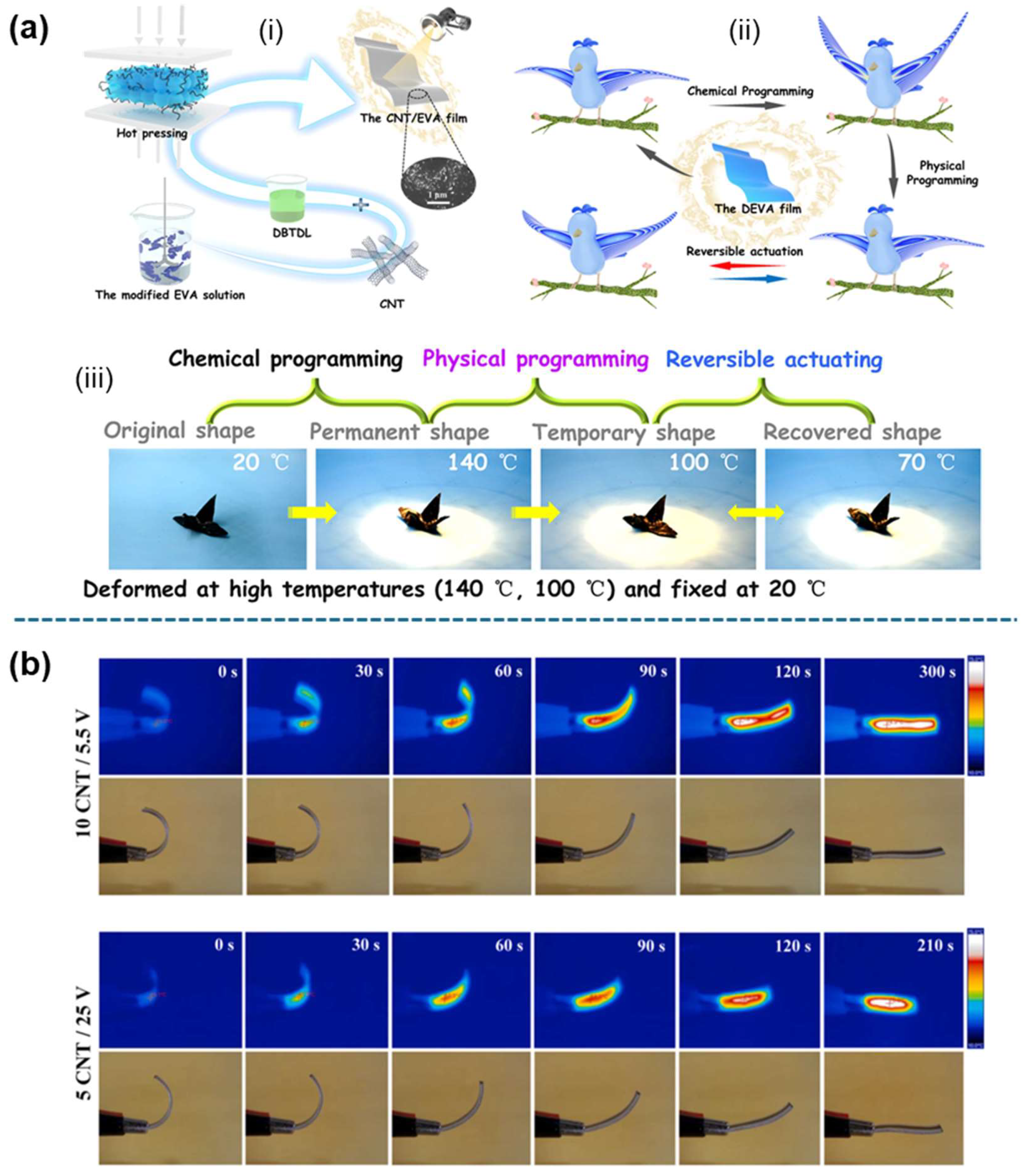
3.2.2. Carbon Nanofiber (CNF) and Carbon Black (CB) Nanocomposites
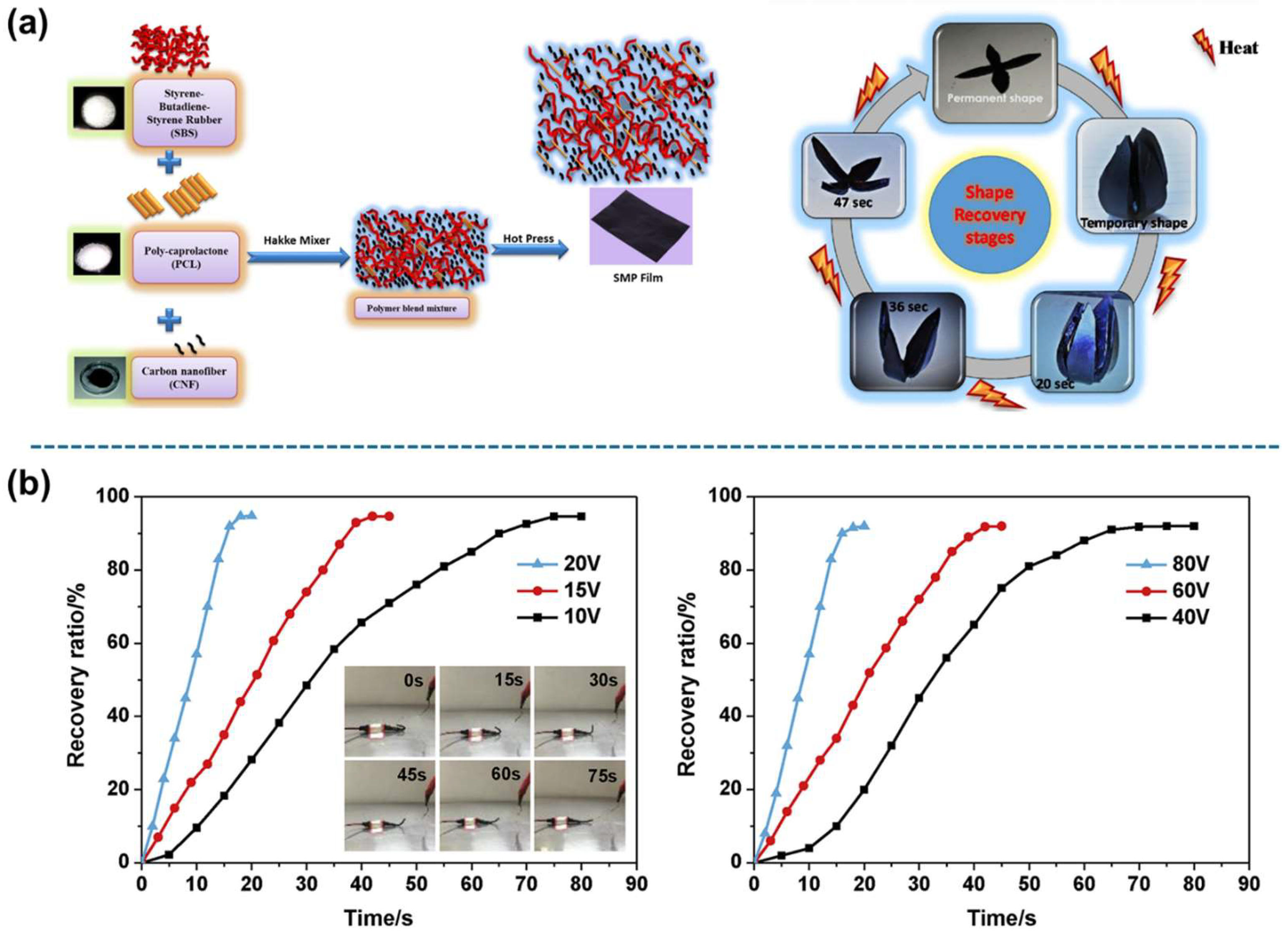
3.2.3. Nanostructured Cellulose Nanocomposites

3.2.4. Graphene Oxide Nanocomposites
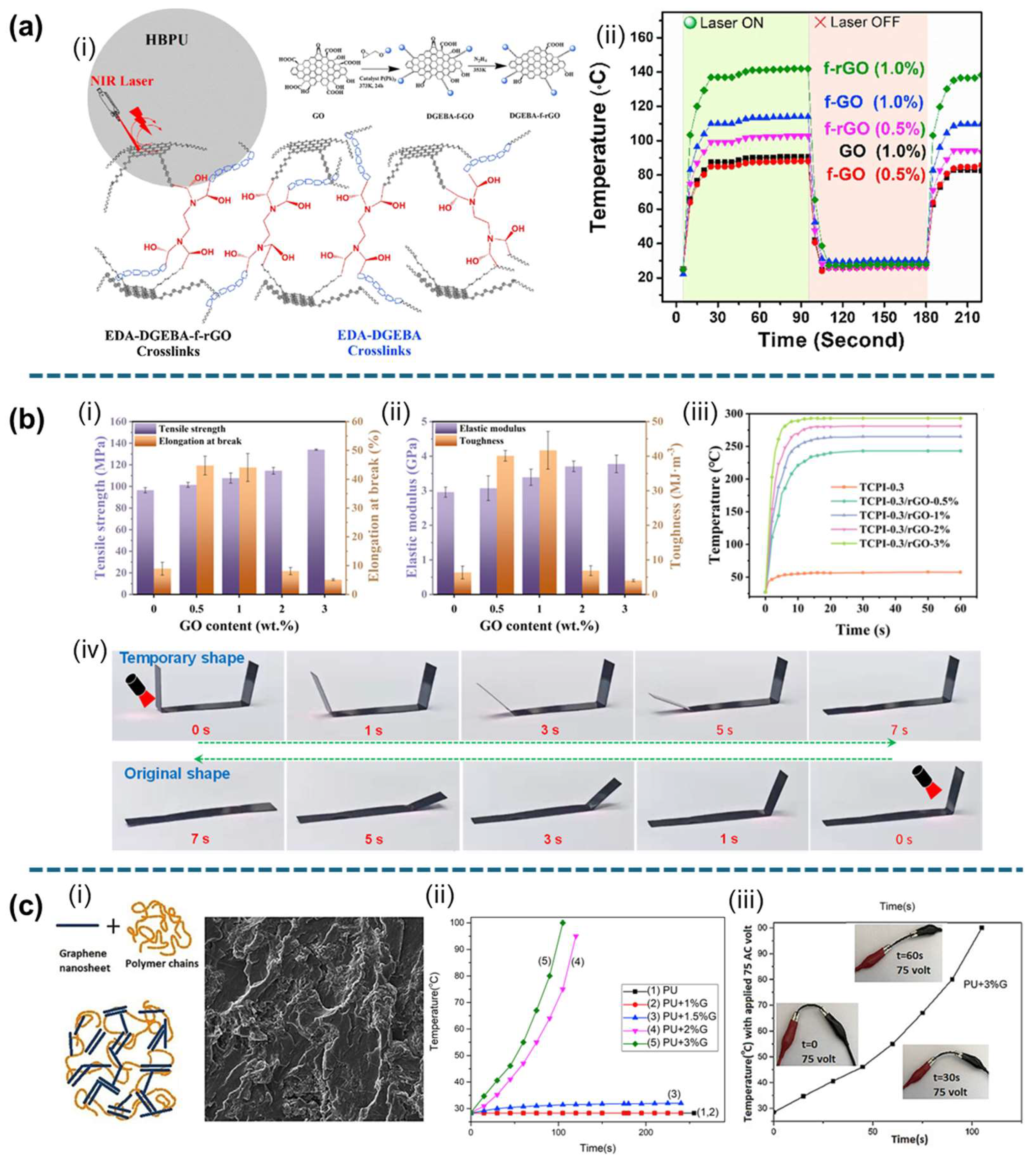
3.2.5. Clay Nanocomposites
3.3. Other Non-Metal Nanocomposites

| Nanofillers | Polymer Matrix | Temperature (Trans) °C | External Stimuli | Shape Recovery (Rr) % | Shape Fixity (Rf) % | Shape Recovery Time (t) s | Reference |
|---|---|---|---|---|---|---|---|
| Fe3O4 | bio-based benzoxazine | − | magnetic field, light | 99 | 93 | 26 | [51] |
| polylactic acid (PLA)/thermoplastic polyurethane (TPU) | 80 | magnetic field | 96 | ~100 | 40 | [67] | |
| polyurethane (PU) | 42 | magnetic field | >96 | − | 90 | [68] | |
| cellulose/polycaprolactone (PCL) | 75 | thermal, NIR | 96 | 98 | − | [75] | |
| polyhydroxyurethane (PHU) | − | magnetic field, NIR | − | − | 39 | [76] | |
| polyurethane acrylate (PUA) | 45 | magnetic field | 99.5 | >97 | 130 | [69] | |
| AuNPs | PCL | 56 | NIR | − | − | 53 | [85] |
| PCL | − | light | >95 | >95 | − | [89] | |
| poly(L-lactide-co-ε-caprolactone) (PLCL) | ~55 | NIR | 84.3 | 93.1 | − | [80] | |
| d,l-lactide (LA) and ε-caprolactone (CL) | 57 | NIR | ~100 | ~100 | − | [100] | |
| AgNPs | PUA-PCL | − | electric/moisture | 98 | ~100 | 10 | [44] |
| polybenzoxazine (PmBz) and PCL | 57 | laser | 99.10 | 99.81 | 40 | [57] | |
| potato starch (PS) | 31 | thermal | ~100 | ~100 | 120 | [118] | |
| W18O49 | polyethylene glycol diacrylate (cPEGDA) | ~61 | NIR | 98.42 | 99.54 | 10 | [72] |
| PCL | ~50 | laser | 96.3 | 97.1 | − | [125] | |
| TiO2 | poly (L-lactide) (PLLA) | 57 | heat | 94.4 | 93.9 | 15 | [126] |
| MgO | PLA | 45 | heat | >82 | >99 | − | [131] |
| CNTs | PU and poly(vinylidene difluoride) (PVDF) | 40 | electricity | 95 | − | 15 | [149] |
| poly(propylene carbonate) (PPC) and PLA | − | electricity | 97 | − | 30 | [150] | |
| poly(ethylene glycol) diacrylate/poly(hydroxyethyl methacrylate) | − | electricity | >95 | ~100 | 204 | [13] | |
| PCL | 43 | electricity | ~99 | ~99 | − | [55] | |
| epoxy polymer matrix | ~40 | heat and NIR | 92.1 | 80.1 | − | [153] | |
| cyanate ester/epoxy resin | − | heat | >99 | 99.5 | 92 | [154] | |
| cardanol-based benzoxazines | 70 | microwave | 100 | >98 | 57 | [156] | |
| CNFs | PCL and Polystyrene-block-Polybutadiene-block-Polystyrene (SBS) | − | heat | 100 | 100 | 47 | [174] |
| hydroxyl-terminated polybutadiene (HTPB) and polytetramethylene glycol (PTMG) | − | heat | >95.5 | − | 38 | [175] | |
| CB | PU | ~40 | electricity | 100 | − | 26 | [180] |
| polyolefin elastomer (POE)/lauric acid (LA) | 65 | heat, electricity, solvent | 95 | − | 20 | [182] | |
| CNs | chitosan | − | water | 90 | − | <3 | [54] |
| polyvinyl alcohol (PVA)/lignin (LIG)/citric acid (CA) | − | water | 100 | − | 4 | [209] | |
| PCL | 40 | heat | 98.6 | 94.1 | − | [215] | |
| TPU/carbomer | 60.8 | water, pH, heat | 83.98 | 79.85 | − | [139] | |
| polyacrylamide/gelatin | − | heat | 96.6 | 76.6 | − | [217] | |
| GO | hyperbranched polyurethane/epoxy (HBPU/EP) | − | NIR | >95 | − | 6.5 | [230] |
| Cross-linked polyimide | >200 | NIR | 98 | 99 | 7 | [236] | |
| Polystyrene (PS)/TPU | 51.7 | heat | 100 | 100 | 22 | [237] | |
| PU | ~36 | electricity | 100 | 83.4 | 60 | [238] | |
| polyvinyl alcohol (PVA) | − | heat, microwave | 100 | 84 | 9 | [240] | |
| Nanoclay | PLA/TPU | 170 | heat | 60.62 | 99.76 | − | [253] |
| PU | 37 | heat | 76 | 94 | − | [258] | |
| PDA NPs | PCL/hexamethylene diisocyanate (HDI)/1,4-butanediol (BDO) | 45 | NIR | ~100 | 100 | 20 | [260] |
4. Applications
4.1. Biomedical Applications
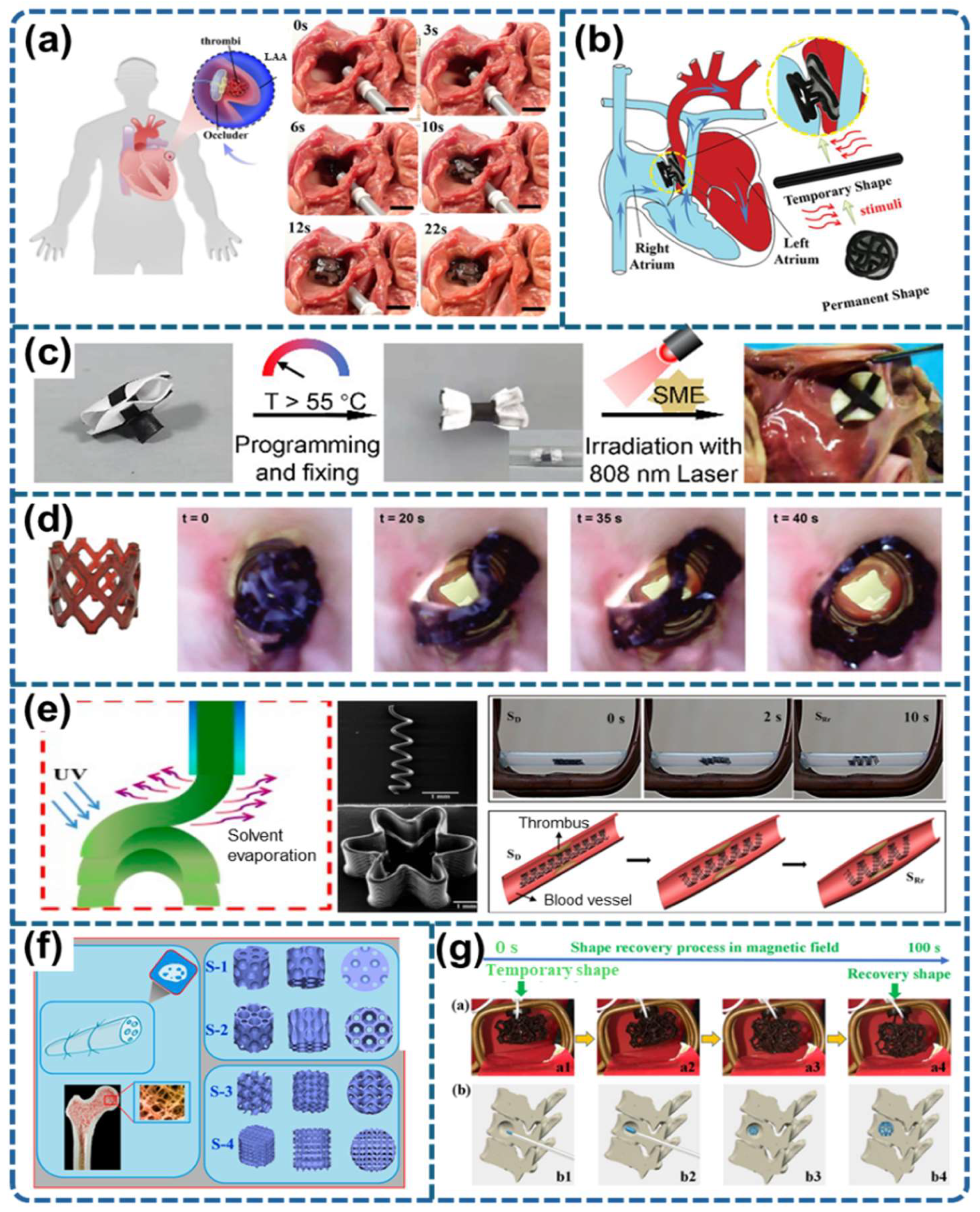
4.2. Flexible Electronics
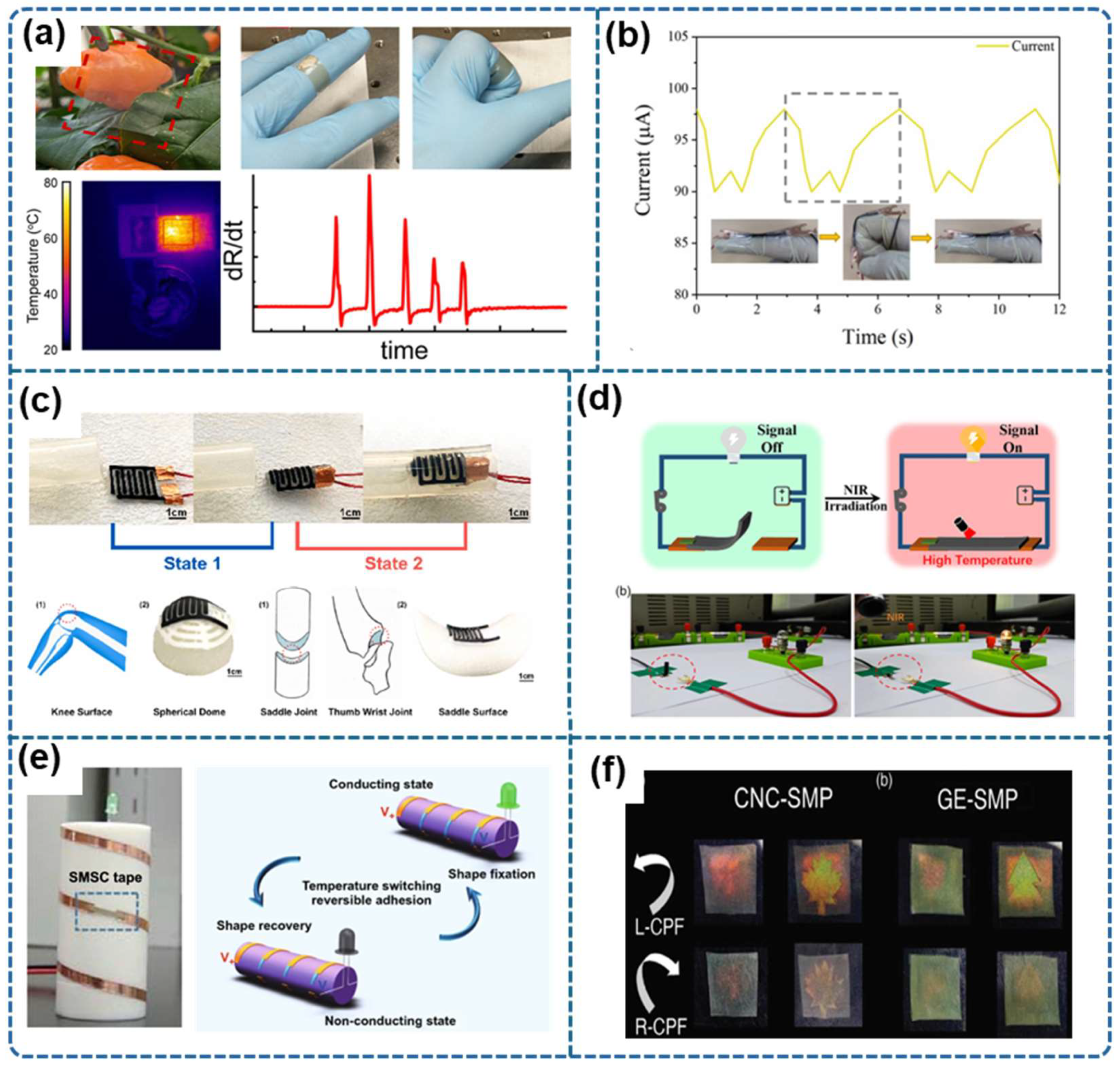
4.3. Soft Robotics

4.4. Other Applications
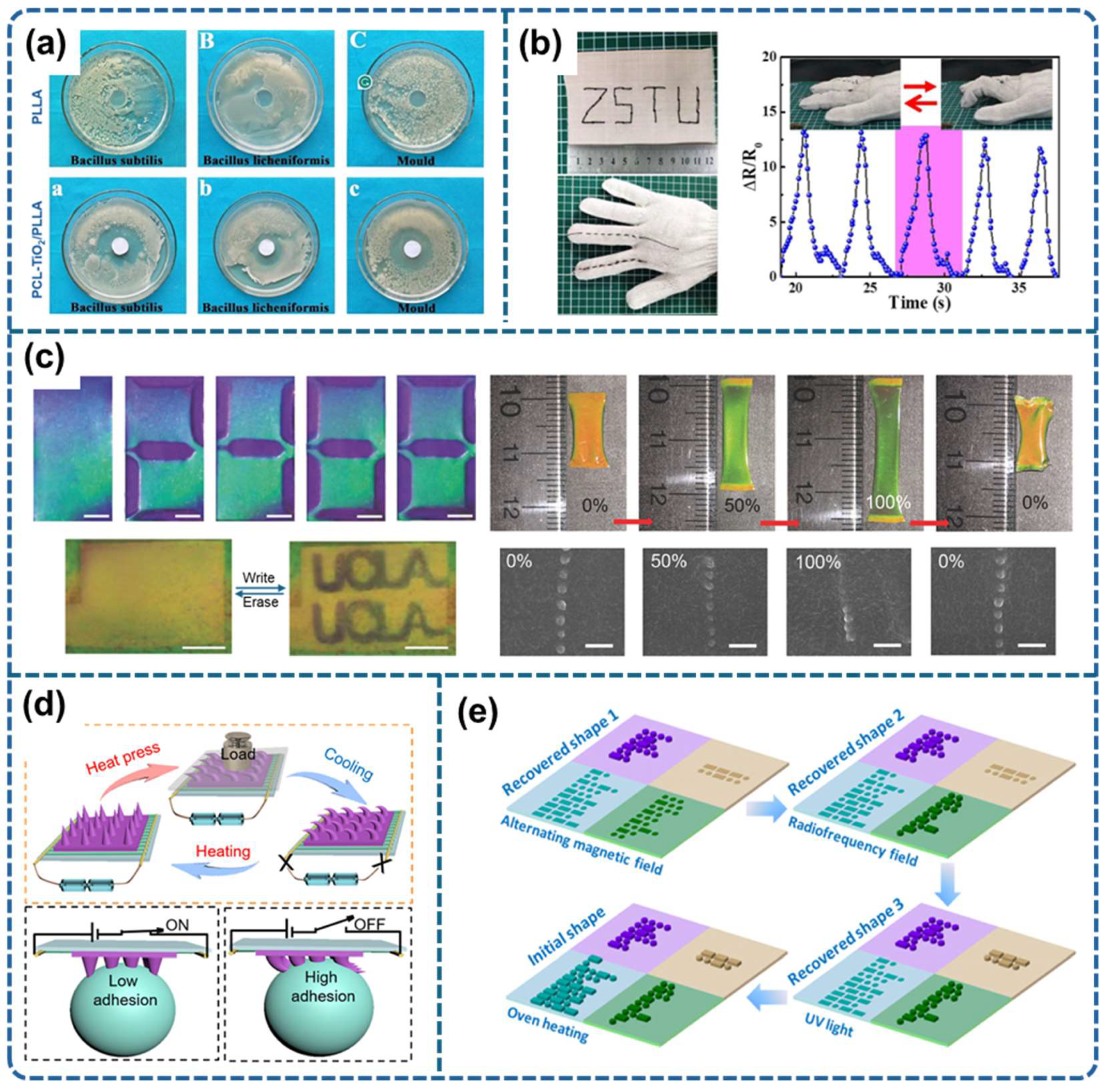
5. Discussion
6. Prospects and Emerging Trends
7. Conclusions
Author Contributions
Funding
Acknowledgments
Conflicts of Interest
References
- Forterre, Y.; Skotheim, J.M.; Dumais, J.; Mahadevan, L. How the Venus Flytrap Snaps. Nature 2005, 433, 421–425. [Google Scholar] [CrossRef] [PubMed]
- Ren, H.; Huang, Y.; Xu, W.; Liu, Y. Electro-Activated Shape Memory Behavior of a Three-Dimensional Lightweight Knitted Tubular Composite. Compos. Commun. 2023, 38, 101517. [Google Scholar] [CrossRef]
- Bhanushali, H.; Amrutkar, S.; Mestry, S.; Mhaske, S. Shape Memory Polymer Nanocomposite: A Review on Structure–Property Relationship. Polym. Bull. 2022, 79, 3437–3493. [Google Scholar] [CrossRef]
- Peng, B.; Yang, Y.; Ju, T.; Cavicchi, K.A. Fused Filament Fabrication 4D Printing of a Highly Extensible, Self-Healing, Shape Memory Elastomer Based on Thermoplastic Polymer Blends. ACS Appl. Mater. Interfaces 2020, 13, 12777–12788. [Google Scholar] [CrossRef]
- Liu, C.; Qin, H.; Mather, P. Review of Progress in Shape-Memory Polymers. J. Mater. Chem. 2007, 17, 1543–1558. [Google Scholar] [CrossRef]
- Rose, A.; Zhu, Z.; Madigan, C.F.; Swager, T.M.; Bulović, V. Sensitivity Gains in Chemosensing by Lasing Action in Organic Polymers. Nature 2005, 434, 876–879. [Google Scholar] [CrossRef] [PubMed]
- Zhang, P.; Wu, B.; Huang, S.; Cai, F.; Wang, G.; Yu, H. UV–Vis–NIR Light-Induced Bending of Shape-Memory Polyurethane Composites Doped with Azobenzene and Upconversion Nanoparticles. Polymer 2019, 178, 121644. [Google Scholar] [CrossRef]
- Li, W.; Liu, Y.; Leng, J. Light-Actuated Reversible Shape Memory Effect of a Polymer Composite. Compos. Part Appl. Sci. Manuf. 2018, 110, 70–75. [Google Scholar] [CrossRef]
- Ramezani, M.; Monroe, M.B.B. Biostable Segmented Thermoplastic Polyurethane Shape Memory Polymers for Smart Biomedical Applications. ACS Appl. Polym. Mater. 2022, 4, 1956–1965. [Google Scholar] [CrossRef]
- Mohr, R.; Kratz, K.; Weigel, T.; Lucka-Gabor, M.; Moneke, M.; Lendlein, A. Initiation of Shape-Memory Effect by Inductive Heating of Magnetic Nanoparticles in Thermoplastic Polymers. Proc. Natl. Acad. Sci. USA 2006, 103, 3540–3545. [Google Scholar] [CrossRef] [PubMed]
- Chen, Y.; Zhao, X.; Li, Y.; Jin, Z.-Y.; Yang, Y.; Yang, M.-B.; Yin, B. Light-and Magnetic-Responsive Synergy Controlled Reconfiguration of Polymer Nanocomposites with Shape Memory Assisted Self-Healing Performance for Soft Robotics. J. Mater. Chem. C 2021, 9, 5515–5527. [Google Scholar] [CrossRef]
- Zeng, C.; Liu, L.; Bian, W.; Liu, Y.; Leng, J. 4D Printed Electro-Induced Continuous Carbon Fiber Reinforced Shape Memory Polymer Composites with Excellent Bending Resistance. Compos. Part B Eng. 2020, 194, 108034. [Google Scholar] [CrossRef]
- Cortés, A.; Cosola, A.; Sangermano, M.; Campo, M.; González Prolongo, S.; Pirri, C.F.; Jiménez-Suárez, A.; Chiappone, A. DLP 4D-Printing of Remotely, Modularly, and Selectively Controllable Shape Memory Polymer Nanocomposites Embedding Carbon Nanotubes. Adv. Funct. Mater. 2021, 31, 2106774. [Google Scholar] [CrossRef]
- Lendlein, A.; Langer, R. Biodegradable, Elastic Shape-Memory Polymers for Potential Biomedical Applications. Science 2002, 296, 1673–1676. [Google Scholar] [CrossRef]
- Jiang, Z.-C.; Xiao, Y.-Y.; Kang, Y.; Pan, M.; Li, B.-J.; Zhang, S. Shape Memory Polymers Based on Supramolecular Interactions. ACS Appl. Mater. Interfaces 2017, 9, 20276–20293. [Google Scholar] [CrossRef] [PubMed]
- Hager, M.D.; Bode, S.; Weber, C.; Schubert, U.S. Shape Memory Polymers: Past, Present and Future Developments. Prog. Polym. Sci. 2015, 49, 3–33. [Google Scholar] [CrossRef]
- Ratna, D.; Karger-Kocsis, J. Recent Advances in Shape Memory Polymers and Composites: A Review. J. Mater. Sci. 2008, 43, 254–269. [Google Scholar] [CrossRef]
- Leng, J.; Lan, X.; Liu, Y.; Du, S. Shape-Memory Polymers and Their Composites: Stimulus Methods and Applications. Prog. Mater. Sci. 2011, 56, 1077–1135. [Google Scholar] [CrossRef]
- Idumah, C.I.; Odera, R.; Ezeani, E.; Low, J.H.; Tanjung, F.; Damiri, F.; Luing, W.S. Construction, Characterization, Properties and Multifunctional Applications of Stimuli-Responsive Shape Memory Polymeric Nanoarchitectures: A Review. Polym.-Plast. Technol. Mater. 2023, 62, 1247–1272. [Google Scholar] [CrossRef]
- Liu, T.; Zhou, T.; Yao, Y.; Zhang, F.; Liu, L.; Liu, Y.; Leng, J. Stimulus Methods of Multi-Functional Shape Memory Polymer Nanocomposites: A Review. Compos. Part Appl. Sci. Manuf. 2017, 100, 20–30. [Google Scholar] [CrossRef]
- Meng, H.; Li, G. A Review of Stimuli-Responsive Shape Memory Polymer Composites. Polymer 2013, 54, 2199–2221. [Google Scholar] [CrossRef]
- Hussain, F.; Hojjati, M.; Okamoto, M.; Gorga, R.E. Polymer-Matrix Nanocomposites, Processing, Manufacturing, and Application: An Overview. J. Compos. Mater. 2006, 40, 1511–1575. [Google Scholar] [CrossRef]
- Panahi-Sarmad, M.; Abrisham, M.; Noroozi, M.; Amirkiai, A.; Dehghan, P.; Goodarzi, V.; Zahiri, B. Deep Focusing on the Role of Microstructures in Shape Memory Properties of Polymer Composites: A Critical Review. Eur. Polym. J. 2019, 117, 280–303. [Google Scholar] [CrossRef]
- Boudjellal, A.; Trache, D.; Khimeche, K.; Hafsaoui, S.L.; Bougamra, A.; Tcharkhtchi, A.; Durastanti, J.-F. Stimulation and Reinforcement of Shape-Memory Polymers and Their Composites: A Review. J. Thermoplast. Compos. Mater. 2022, 35, 2227–2260. [Google Scholar] [CrossRef]
- Zhao, W.; Li, N.; Liu, L.; Leng, J.; Liu, Y. Mechanical Behaviors and Applications of Shape Memory Polymer and Its Composites. Appl. Phys. Rev. 2023, 10, 011306. [Google Scholar] [CrossRef]
- Wang, Y.; Li, G.; Yang, L.; Luo, R.; Guo, G. Development of Innovative Biomaterials and Devices for the Treatment of Cardiovascular Diseases. Adv. Mater. 2022, 34, 2201971. [Google Scholar] [CrossRef]
- Godart, F.; Houeijeh, A.; Recher, M.; Francart, C.; Polge, A.-S.; Richardson, M.; Cajot, M.-A.; Duhamel, A. Transcatheter Closure of Atrial Septal Defect with the Figulla® ASD Occluder: A Comparative Study with the Amplatzer® Septal Occluder. Arch. Cardiovasc. Dis. 2015, 108, 57–63. [Google Scholar] [CrossRef]
- Small, W.; Buckley, P.R.; Wilson, T.S.; Benett, W.J.; Hartman, J.; Saloner, D.; Maitland, D.J. Shape Memory Polymer Stent with Expandable Foam: A New Concept for Endovascular Embolization of Fusiform Aneurysms. IEEE Trans. Biomed. Eng. 2007, 54, 1157–1160. [Google Scholar] [CrossRef]
- Xia, Y.; He, Y.; Zhang, F.; Liu, Y.; Leng, J. A Review of Shape Memory Polymers and Composites: Mechanisms, Materials, and Applications. Adv. Mater. 2021, 33, 2000713. [Google Scholar] [CrossRef] [PubMed]
- Gao, H.; Li, J.; Zhang, F.; Liu, Y.; Leng, J. The Research Status and Challenges of Shape Memory Polymer-Based Flexible Electronics. Mater. Horiz. 2019, 6, 931–944. [Google Scholar] [CrossRef]
- Nasseri, R.; Bouzari, N.; Huang, J.; Golzar, H.; Jankhani, S.; Tang, X.; Mekonnen, T.H.; Aghakhani, A.; Shahsavan, H. Programmable Nanocomposites of Cellulose Nanocrystals and Zwitterionic Hydrogels for Soft Robotics. Nat. Commun. 2023, 14, 6108. [Google Scholar] [CrossRef]
- Toncheva, A.; Khelifa, F.; Paint, Y.; Voué, M.; Lambert, P.; Dubois, P.; Raquez, J.-M. Fast IR-Actuated Shape-Memory Polymers Using in Situ Silver Nanoparticle-Grafted Cellulose Nanocrystals. ACS Appl. Mater. Interfaces 2018, 10, 29933–29942. [Google Scholar] [CrossRef] [PubMed]
- Göldel, A.; Marmur, A.; Kasaliwal, G.R.; Pötschke, P.; Heinrich, G. Shape-Dependent Localization of Carbon Nanotubes and Carbon Black in an Immiscible Polymer Blend during Melt Mixing. Macromolecules 2011, 44, 6094–6102. [Google Scholar] [CrossRef]
- Vernon, L.B.; Vernon, H.M. Process of Manufacturing Articles of Thermoplastic Synthetic Resins. U.S. Patent No. 2,234,993, 18 March 1941. [Google Scholar]
- Jia, J.; Wang, J.; Wang, Y. Shape Memory Polymer-Based Thermal-Responsive Circuit Switches. J. Mater. Chem. C 2023, 11, 6276–6289. [Google Scholar] [CrossRef]
- Lendlein, A.; Gould, O.E. Reprogrammable Recovery and Actuation Behaviour of Shape-Memory Polymers. Nat. Rev. Mater. 2019, 4, 116–133. [Google Scholar] [CrossRef]
- Rokaya, D.; Skallevold, H.E.; Srimaneepong, V.; Marya, A.; Shah, P.K.; Khurshid, Z.; Zafar, M.S.; Sapkota, J. Shape Memory Polymeric Materials for Biomedical Applications: An Update. J. Compos. Sci. 2023, 7, 24. [Google Scholar] [CrossRef]
- Xie, T. Recent Advances in Polymer Shape Memory. Polymer 2011, 52, 4985–5000. [Google Scholar] [CrossRef]
- Rousseau, I.A.; Mather, P.T. Shape Memory Effect Exhibited by Smectic-C Liquid Crystalline Elastomers. J. Am. Chem. Soc. 2003, 125, 15300–15301. [Google Scholar] [CrossRef]
- Yao, Y.; Xu, Y.; Chen, H.; Kang, Y.; Liu, Y.; Leng, J. Fabrication and Characterization of Shape Memory Auxetic Metamaterial. J. Intell. Mater. Syst. Struct. 2023, 34, 101–110. [Google Scholar] [CrossRef]
- Quadrini, F.; Bellisario, D.; Ciampoli, L.; Costanza, G.; Santo, L. Auxetic Epoxy Foams Produced by Solid State Foaming. J. Cell. Plast. 2016, 52, 441–454. [Google Scholar] [CrossRef]
- Luo, X.; Mather, P.T. Conductive Shape Memory Nanocomposites for High Speed Electrical Actuation. Soft Matter 2010, 6, 2146–2149. [Google Scholar] [CrossRef]
- Ze, Q.; Kuang, X.; Wu, S.; Wong, J.; Montgomery, S.M.; Zhang, R.; Kovitz, J.M.; Yang, F.; Qi, H.J.; Zhao, R. Magnetic Shape Memory Polymers with Integrated Multifunctional Shape Manipulation. Adv. Mater. 2020, 32, 1906657. [Google Scholar] [CrossRef]
- Xing, S.; Wang, P.; Liu, S.; Xu, Y.; Zheng, R.; Deng, Z.; Peng, Z.; Li, J.; Wu, Y.; Liu, L. A Shape-Memory Soft Actuator Integrated with Reversible Electric/Moisture Actuating and Strain Sensing. Compos. Sci. Technol. 2020, 193, 108133. [Google Scholar] [CrossRef]
- Yang, Q.; Zheng, W.; Zhao, W.; Peng, C.; Ren, J.; Yu, Q.; Hu, Y.; Zhang, X. One-Way and Two-Way Shape Memory Effects of a High-Strain Cis-1, 4-Polybutadiene–Polyethylene Copolymer Based Dynamic Network via Self-Complementary Quadruple Hydrogen Bonding. Polym. Chem. 2019, 10, 718–726. [Google Scholar] [CrossRef]
- Qi, X.; Wang, W.; Dai, H.; Zhu, Y.; Dong, Y.; Fu, S.-Y.; Ni, Q.; Fu, Y. Multifunctional Two-Way Shape Memory RGO/Ethylene-Vinyl Acetate Composite Yarns for Electro-Driven Actuators and High Sensitivity Strain Sensors. Compos. Part Appl. Sci. Manuf. 2023, 169, 107521. [Google Scholar] [CrossRef]
- Zare, M.; Prabhakaran, M.P.; Parvin, N.; Ramakrishna, S. Thermally-Induced Two-Way Shape Memory Polymers: Mechanisms, Structures, and Applications. Chem. Eng. J. 2019, 374, 706–720. [Google Scholar] [CrossRef]
- Xiao, H.; Ma, C.; Le, X.; Wang, L.; Lu, W.; Theato, P.; Hu, T.; Zhang, J.; Chen, T. A Multiple Shape Memory Hydrogel Induced by Reversible Physical Interactions at Ambient Condition. Polymers 2017, 9, 138. [Google Scholar] [CrossRef]
- Dayyoub, T.; Maksimkin, A.V.; Filippova, O.V.; Tcherdyntsev, V.V.; Telyshev, D.V. Shape Memory Polymers as Smart Materials: A Review. Polymers 2022, 14, 3511. [Google Scholar] [CrossRef] [PubMed]
- Soto, G.D.; Meiorin, C.; Actis, D.G.; Zélis, P.M.; Londoño, O.M.; Muraca, D.; Mosiewicki, M.A.; Marcovich, N.E. Magnetic Nanocomposites Based on Shape Memory Polyurethanes. Eur. Polym. J. 2018, 109, 8–15. [Google Scholar] [CrossRef]
- Leungpuangkaew, S.; Amornkitbamrung, L.; Phetnoi, N.; Sapcharoenkun, C.; Jubsilp, C.; Ekgasit, S.; Rimdusit, S. Magnetic-and Light-Responsive Shape Memory Polymer Nanocomposites from Bio-Based Benzoxazine Resin and Iron Oxide Nanoparticles. Adv. Ind. Eng. Polym. Res. 2023, 6, 215–225. [Google Scholar] [CrossRef]
- Ren, Y.; Zhang, Z.; Xia, W.; Zhou, Q.; Song, X. Water-Responsive Shape Memory PLLA via Incorporating PCL-(PMVS-s-PAA)-PCL-PTMG-PCL-(PMVS-s-PAA)-PCL. Eur. Polym. J. 2021, 147, 110252. [Google Scholar] [CrossRef]
- Song, L.; Li, Y.; Xiong, Z.; Pan, L.; Xu, X.; Lu, S. Water-Induced Shape Memory Effect of Nanocellulose Papers from Sisal Cellulose Nanofibers with Graphene Oxide. Carbohydr. Polym. 2018, 179, 110–117. [Google Scholar] [CrossRef] [PubMed]
- Wu, M.; Sukyai, P.; Lv, D.; Zhang, F.; Wang, P.; Liu, C.; Li, B. Water and Humidity-Induced Shape Memory Cellulose Nanopaper with Quick Response, Excellent Wet Strength and Folding Resistance. Chem. Eng. J. 2020, 392, 123673. [Google Scholar] [CrossRef]
- Houbben, M.; Sànchez, C.P.; Vanderbemden, P.; Noels, L.; Jérôme, C. MWCNTs Filled PCL Covalent Adaptable Networks: Towards Reprocessable, Self-Healing and Fast Electrically-Triggered Shape-Memory Composites. Polymer 2023, 278, 125992. [Google Scholar] [CrossRef]
- Zhang, Z.; Wang, J.; Nie, X.; Wen, T.; Ji, Y.; Wu, X.; Zhao, Y.; Chen, C. Near Infrared Laser-Induced Targeted Cancer Therapy Using Thermoresponsive Polymer Encapsulated Gold Nanorods. J. Am. Chem. Soc. 2014, 136, 7317–7326. [Google Scholar] [CrossRef]
- Yenpech, N.; Intasanta, V.; Chirachanchai, S. Laser-Triggered Shape Memory Based on Thermoplastic and Thermoset Matrices with Silver Nanoparticles. Polymer 2019, 182, 121792. [Google Scholar] [CrossRef]
- Das, N.; Chaki, T.; Khastgir, D. Effect of Filler Treatment and Crosslinking on Mechanical and Dynamic Mechanical Properties and Electrical Conductivity of Carbon Black-filled Ethylene–Vinyl Acetate Copolymer Composites. J. Appl. Polym. Sci. 2003, 90, 2073–2082. [Google Scholar] [CrossRef]
- Horastani, S.J.; Ghane, M.; Karevan, M. Production and Performance of a Low Temperature Shape-Memory Actuator Based on Twisted-Coiled Spring Mechanics. Smart Mater. Struct. 2022, 31, 105005. [Google Scholar] [CrossRef]
- Kalita, H.; Karak, N. Hyperbranched Polyurethane/Fe3O4 Thermosetting Nanocomposites as Shape Memory Materials. Polym. Bull. 2013, 70, 2953–2965. [Google Scholar] [CrossRef]
- Razzaq, M.Y.; Anhalt, M.; Frormann, L.; Weidenfeller, B. Thermal, Electrical and Magnetic Studies of Magnetite Filled Polyurethane Shape Memory Polymers. Mater. Sci. Eng. A 2007, 444, 227–235. [Google Scholar] [CrossRef]
- Du, L.; Xu, Z.-Y.; Fan, C.-J.; Xiang, G.; Yang, K.-K.; Wang, Y.-Z. A Fascinating Metallo-Supramolecular Polymer Network with Thermal/Magnetic/Light-Responsive Shape-Memory Effects Anchored by Fe3O4 Nanoparticles. Macromolecules 2018, 51, 705–715. [Google Scholar] [CrossRef]
- Zou, H.; Weder, C.; Simon, Y.C. Shape-Memory Polyurethane Nanocomposites with Single Layer or Bilayer Oleic Acid-Coated Fe3O4 Nanoparticles. Macromol. Mater. Eng. 2015, 300, 885–892. [Google Scholar] [CrossRef]
- Issa, B.; Obaidat, I.M.; Albiss, B.A.; Haik, Y. Magnetic Nanoparticles: Surface Effects and Properties Related to Biomedicine Applications. Int. J. Mol. Sci. 2013, 14, 21266–21305. [Google Scholar] [CrossRef] [PubMed]
- Gao, Y.; Zhu, G.; Xu, S.; Ma, T.; Nie, J. Biodegradable Magnetic-sensitive Shape Memory Poly(ε-caprolactone)/Fe3O4 Nanocomposites. J. Appl. Polym. Sci. 2018, 135, 45652. [Google Scholar] [CrossRef]
- Ruenpanya, K.; Mora, P.; Karagiannidis, P.; Bunyanuwat, K.; Rimdusit, S. Magnetic-Responsive Triple Shape Memory Polymer from Bio-Based Benzoxazine/Urethane Polymer Alloys with Iron Oxide Nanoparticles. Adv. Ind. Eng. Polym. Res. 2024, 8, 37–47. [Google Scholar] [CrossRef]
- Liu, H.; Wang, F.; Wu, W.; Dong, X.; Sang, L. 4D Printing of Mechanically Robust PLA/TPU/Fe3O4 Magneto-Responsive Shape Memory Polymers for Smart Structures. Compos. Part B Eng. 2023, 248, 110382. [Google Scholar] [CrossRef]
- Babaie, A.; Rezaei, M.; Razzaghi, D.; Roghani-Mamaqani, H. Synthesis of Dual-stimuli-responsive Polyurethane Shape Memory Nanocomposites Incorporating Isocyanate-functionalized Fe3O4 Nanoparticles. J. Appl. Polym. Sci. 2022, 139, e52790. [Google Scholar] [CrossRef]
- Khasraghi, S.S.; Shojaei, A.; Janmaleki, M.; Sundararaj, U. Efficient Inductively Heated Shape Memory Polyurethane Acrylate Network with Silane Modified Nanodiamond@Fe3O4 Superparamagnetic Nanohybrid. Eur. Polym. J. 2021, 159, 110735. [Google Scholar] [CrossRef]
- Huang, J.; Fan, J.; Yin, S.; Chen, Y. Design of Remotely, Locally Triggered Shape-Memory Materials Based on Bicontinuous Polylactide/Epoxidized Natural Rubber Thermoplastic Vulcanizates via Regulating the Distribution of Ferroferric Oxide. Compos. Sci. Technol. 2019, 182, 107732. [Google Scholar] [CrossRef]
- Huang, J.; Cao, L.; Yuan, D.; Chen, Y. Design of Multi-Stimuli-Responsive Shape Memory Biobased PLA/ENR/Fe3O4 TPVs with Balanced Stiffness–Toughness Based on Selective Distribution of Fe3O4. ACS Sustain. Chem. Eng. 2018, 7, 2304–2315. [Google Scholar] [CrossRef]
- Zhou, Y.; Tan, J.; Chong, D.; Wan, X.; Zhang, J. Rapid Near-infrared Light Responsive Shape Memory Polymer Hybrids and Novel Chiral Actuators Based on Photothermal W18O49 Nanowires. Adv. Funct. Mater. 2019, 29, 1901202. [Google Scholar] [CrossRef]
- Bai, Y.; Zhang, J.; Wen, D.; Gong, P.; Liu, J.; Ju, J.; Chen, X. A Reconfigurable, Self-Healing and near Infrared Light Responsive Thermoset Shape Memory Polymer. Compos. Sci. Technol. 2020, 187, 107940. [Google Scholar] [CrossRef]
- Wu, S.; Li, W.; Sun, Y.; Pang, X.; Zhang, X.; Zhuang, J.; Zhang, H.; Hu, C.; Lei, B.; Liu, Y. Facile Fabrication of a CD/PVA Composite Polymer to Access Light-Responsive Shape-Memory Effects. J. Mater. Chem. C 2020, 8, 8935–8941. [Google Scholar] [CrossRef]
- Lu, C.; Shen, Y.; Wang, X.; Xu, S.; Wang, J.; Yong, Q.; Chu, F. Biomimetic Ultra-Strong, Ultra-Tough, Degradable Cellulose-Based Composites for Multi-Stimuli Responsive Shape Memory. Int. J. Biol. Macromol. 2023, 226, 1468–1476. [Google Scholar] [CrossRef] [PubMed]
- Li, L.; Zhao, B.; Wang, H.; Gao, Y.; Hu, J.; Zheng, S. Nanocomposites of Polyhydroxyurethane with Fe3O4 Nanoparticles: Synthesis, Shape Memory and Reprocessing Properties. Compos. Sci. Technol. 2021, 215, 109009. [Google Scholar] [CrossRef]
- Zheng, Y.; Mei, H.; Ullah, S.; Saeed, M.U.; Li, L.; Zheng, S. Reprocessing and Reconfigurable Shape Recovery of Epoxy and Fe3O4 Nanocomposites Enabled by Crosslinking with a Polymeric Hardener Bearing Disulfide Bonds. React. Funct. Polym. 2023, 193, 105768. [Google Scholar] [CrossRef]
- Zhang, H.; Xia, H.; Zhao, Y. Optically Triggered and Spatially Controllable Shape-Memory Polymer–Gold Nanoparticle Composite Materials. J. Mater. Chem. 2012, 22, 845–849. [Google Scholar] [CrossRef]
- Fang, L.; Fang, T.; Liu, X.; Ni, Y.; Lu, C.; Xu, Z. Precise Stimulation of Near-Infrared Light Responsive Shape-Memory Polymer Composites Using Upconversion Particles with Photothermal Capability. Compos. Sci. Technol. 2017, 152, 190–197. [Google Scholar] [CrossRef]
- Xiang, Z.; Zhang, J.; Zhou, C.; Zhang, B.; Chen, N.; Li, M.; Fu, D.; Wang, Y. Near-Infrared Remotely Controllable Shape Memory Biodegradable Occluder Based on Poly(l-Lactide-Co-ε-Caprolactone)/Gold Nanorod Composite. ACS Appl. Mater. Interfaces 2023, 15, 42341–42353. [Google Scholar] [CrossRef]
- Ngo, N.M.; Tran, H.-V.; Lee, T.R. Plasmonic Nanostars: Systematic Review of Their Synthesis and Applications. ACS Appl. Nano Mater. 2022, 5, 14051–14091. [Google Scholar] [CrossRef]
- Homaeigohar, S.; Elbahri, M. Switchable Plasmonic Nanocomposites. Adv. Opt. Mater. 2019, 7, 1801101. [Google Scholar] [CrossRef]
- Fortenbaugh, R.J.; Lear, B.J. On-Demand Curing of Polydimethylsiloxane (PDMS) Using the Photothermal Effect of Gold Nanoparticles. Nanoscale 2017, 9, 8555–8559. [Google Scholar] [CrossRef]
- Viswanath, V.; Maity, S.; Bochinski, J.R.; Clarke, L.I.; Gorga, R.E. Thermal Annealing of Polymer Nanocomposites via Photothermal Heating: Effects on Crystallinity and Spherulite Morphology. Macromolecules 2013, 46, 8596–8607. [Google Scholar] [CrossRef]
- Li, S.; Jin, X.; Shao, Y.; Qi, X.; Yang, J.; Wang, Y. Gold Nanoparticle/Reduced Graphene Oxide Hybrids for Fast Light-Actuated Shape Memory Polymers with Enhanced Photothermal Conversion and Mechanical Stiffness. Eur. Polym. J. 2019, 116, 302–310. [Google Scholar] [CrossRef]
- Zhang, P.; Huang, Y.; Lu, X.; Zhang, S.; Li, J.; Wei, G.; Su, Z. One-Step Synthesis of Large-Scale Graphene Film Doped with Gold Nanoparticles at Liquid–Air Interface for Electrochemistry and Raman Detection Applications. Langmuir 2014, 30, 8980–8989. [Google Scholar] [CrossRef] [PubMed]
- Fu, X.; Kuang, P.; Wang, S.; Zhang, G.; Yin, H. Controllable Synthesis of Graphene Oxide–Silver (Gold) Nanocomposites and Their Size-Dependencies. RSC Adv. 2016, 6, 70468–70473. [Google Scholar] [CrossRef]
- Kang, S.; Lee, J.; Ryu, S.; Kwon, Y.; Kim, K.-H.; Jeong, D.H.; Paik, S.R.; Kim, B.-S. Gold Nanoparticle/Graphene Oxide Hybrid Sheets Attached on Mesenchymal Stem Cells for Effective Photothermal Cancer Therapy. Chem. Mater. 2017, 29, 3461–3476. [Google Scholar] [CrossRef]
- Wang, Y.; Sachyani Keneth, E.; Kamyshny, A.; Scalet, G.; Auricchio, F.; Magdassi, S. 4D Multimaterial Printing of Programmable and Selective Light-activated Shape-memory Structures with Embedded Gold Nanoparticles. Adv. Mater. Technol. 2022, 7, 2101058. [Google Scholar] [CrossRef]
- Zhang, H.; Zhao, Y. Polymers with Dual Light-Triggered Functions of Shape Memory and Healing Using Gold Nanoparticles. ACS Appl. Mater. Interfaces 2013, 5, 13069–13075. [Google Scholar] [CrossRef]
- Burnworth, M.; Tang, L.; Kumpfer, J.R.; Duncan, A.J.; Beyer, F.L.; Fiore, G.L.; Rowan, S.J.; Weder, C. Optically Healable Supramolecular Polymers. Nature 2011, 472, 334–337. [Google Scholar] [CrossRef] [PubMed]
- Zheng, X.; Fontana, J.; Pevnyi, M.; Ignatenko, M.; Wang, S.; Vaia, R.; Palffy-Muhoray, P. The Effects of Nanoparticle Shape and Orientation on the Low Frequency Dielectric Properties of Nanocomposites. J. Mater. Sci. 2012, 47, 4914–4920. [Google Scholar] [CrossRef]
- Yadav, P.R.; Rizvi, M.H.; Kuttich, B.; Mishra, S.R.; Chapman, B.S.; Lynch, B.B.; Kraus, T.; Oldenburg, A.L.; Tracy, J.B. Plasmon-Coupled Gold Nanoparticles in Stretched Shape-Memory Polymers for Mechanical/Thermal Sensing. ACS Appl. Nano Mater. 2021, 4, 3911–3921. [Google Scholar] [CrossRef]
- Kennedy, L.C.; Bickford, L.R.; Lewinski, N.A.; Coughlin, A.J.; Hu, Y.; Day, E.S.; West, J.L.; Drezek, R.A. A New Era for Cancer Treatment: Gold-nanoparticle-mediated Thermal Therapies. Small 2011, 7, 169–183. [Google Scholar] [CrossRef] [PubMed]
- Huang, X.; El-Sayed, I.H.; Qian, W.; El-Sayed, M.A. Cancer Cell Imaging and Photothermal Therapy in the Near-Infrared Region by Using Gold Nanorods. J. Am. Chem. Soc. 2006, 128, 2115–2120. [Google Scholar] [CrossRef]
- Zhang, H.; Zhang, J.; Tong, X.; Ma, D.; Zhao, Y. Light Polarization-controlled Shape-memory Polymer/Gold Nanorod Composite. Macromol. Rapid Commun. 2013, 34, 1575–1579. [Google Scholar] [CrossRef] [PubMed]
- Ye, H.; De, S. Thermal Injury of Skin and Subcutaneous Tissues: A Review of Experimental Approaches and Numerical Models. Burns 2017, 43, 909–932. [Google Scholar] [CrossRef]
- Jeon, H.; Lee, K. Effect of Gold Nanoparticle Morphology on Thermal Properties of Polyimide Nanocomposite Films. Colloids Surf. Physicochem. Eng. Asp. 2019, 579, 123651. [Google Scholar] [CrossRef]
- Guo, Q.; Bishop, C.J.; Meyer, R.A.; Wilson, D.R.; Olasov, L.; Schlesinger, D.E.; Mather, P.T.; Spicer, J.B.; Elisseeff, J.H.; Green, J.J. Entanglement-Based Thermoplastic Shape Memory Polymeric Particles with Photothermal Actuation for Biomedical Applications. ACS Appl. Mater. Interfaces 2018, 10, 13333–13341. [Google Scholar] [CrossRef] [PubMed]
- Paunović, N.; Marbach, J.; Bao, Y.; Berger, V.; Klein, K.; Schleich, S.; Coulter, F.B.; Kleger, N.; Studart, A.R.; Franzen, D. Digital Light 3D Printed Bioresorbable and NIR-Responsive Devices with Photothermal and Shape-Memory Functions. Adv. Sci. 2022, 9, 2200907. [Google Scholar] [CrossRef]
- Zheng, Y.; Li, J.; Lee, E.; Yang, S. Light-Induced Shape Recovery of Deformed Shape Memory Polymer Micropillar Arrays with Gold Nanorods. Rsc Adv. 2015, 5, 30495–30499. [Google Scholar] [CrossRef]
- Mishra, S.R.; Tracy, J.B. Sequential Actuation of Shape-Memory Polymers through Wavelength-Selective Photothermal Heating of Gold Nanospheres and Nanorods. ACS Appl. Nano Mater. 2018, 1, 3063–3067. [Google Scholar] [CrossRef]
- Lopez-Carrizales, M.; Mendoza-Mendoza, E.; Peralta-Rodriguez, R.D.; Pérez-Díaz, M.A.; Portales-Pérez, D.; Magaña-Aquino, M.; Aragón-Piña, A.; Infante-Martínez, R.; Barriga-Castro, E.D.; Sánchez-Sánchez, R. Characterization, Antibiofilm and Biocompatibility Properties of Chitosan Hydrogels Loaded with Silver Nanoparticles and Ampicillin: An Alternative Protection to Central Venous Catheters. Colloids Surf. B Biointerfaces 2020, 196, 111292. [Google Scholar] [CrossRef] [PubMed]
- Ringwal, S.; Bartwal, A.S.; Sati, S.C. Photo-Catalytic Degradation of Different Toxic Dyes Using Silver Nanoparticles as Photo-Catalyst, Mediated via Citrus Aurantium Peels Extract. J. Indian Chem. Soc. 2021, 98, 100221. [Google Scholar] [CrossRef]
- Sonseca, A.; Madani, S.; Muñoz-Bonilla, A.; Fernández-García, M.; Peponi, L.; Leonés, A.; Rodríguez, G.; Echeverría, C.; López, D. Biodegradable and Antimicrobial PLA–OLA Blends Containing Chitosan-Mediated Silver Nanoparticles with Shape Memory Properties for Potential Medical Applications. Nanomaterials 2020, 10, 1065. [Google Scholar] [CrossRef]
- Jouni, M.; Boudenne, A.; Boiteux, G.; Massardier, V.; Garnier, B.; Serghei, A. Electrical and Thermal Properties of Polyethylene/Silver Nanoparticle Composites. Polym. Compos. 2013, 34, 778–786. [Google Scholar] [CrossRef]
- Dorigato, A.; Pegoretti, A. Shape Memory Epoxy Nanocomposites with Carbonaceous Fillers and In-situ Generated Silver Nanoparticles. Polym. Eng. Sci. 2019, 59, 694–703. [Google Scholar] [CrossRef]
- Zare, M.; Parvin, N.; Prabhakaran, M.P.; Mohandesi, J.A.; Ramakrishna, S. Highly Porous 3D Sponge-like Shape Memory Polymer for Tissue Engineering Application with Remote Actuation Potential. Compos. Sci. Technol. 2019, 184, 107874. [Google Scholar] [CrossRef]
- Qi, X.; Shao, Y.; Wu, H.; Yang, J.; Wang, Y. Flexible Phase Change Composite Materials with Simultaneous Light Energy Storage and Light-Actuated Shape Memory Capability. Compos. Sci. Technol. 2019, 181, 107714. [Google Scholar] [CrossRef]
- Stroganov, V.; Al-Hussein, M.; Sommer, J.-U.; Janke, A.; Zakharchenko, S.; Ionov, L. Reversible Thermosensitive Biodegradable Polymeric Actuators Based on Confined Crystallization. Nano Lett. 2015, 15, 1786–1790. [Google Scholar] [CrossRef]
- Chen, S.; Yang, S.; Li, Z.; Xu, S.; Yuan, H.; Chen, S.; Ge, Z. Electroactive Two-way Shape Memory Polymer Laminates. Polym. Compos. 2015, 36, 439–444. [Google Scholar] [CrossRef]
- Fan, L.F.; Rong, M.Z.; Zhang, M.Q.; Chen, X.D. Dynamic Reversible Bonds Enable External Stress-Free Two-Way Shape Memory Effect of a Polymer Network and the Interrelated Intrinsic Self-Healability of Wider Crack and Recyclability. J. Mater. Chem. A 2018, 6, 16053–16063. [Google Scholar] [CrossRef]
- Yang, Z.; Wang, Q.; Wang, T. Dual-Triggered and Thermally Reconfigurable Shape Memory Graphene-Vitrimer Composites. ACS Appl. Mater. Interfaces 2016, 8, 21691–21699. [Google Scholar] [CrossRef] [PubMed]
- Weems, A.; Raymond, J.; Easley, A.; Wierzbicki, M.; Gustafson, T.; Monroe, M.; Maitland, D. Shape Memory Polymers with Visible and Near-Infrared Imaging Modalities: Synthesis, Characterization and in Vitro Analysis. RSC Adv. 2017, 7, 19742–19753. [Google Scholar] [CrossRef]
- Rimdusit, S.; Lohwerathama, M.; Hemvichian, K.; Kasemsiri, P.; Dueramae, I. Shape Memory Polymers from Benzoxazine-Modified Epoxy. Smart Mater. Struct. 2013, 22, 075033. [Google Scholar] [CrossRef]
- Xiao, X.; Kong, D.; Qiu, X.; Zhang, W.; Liu, Y.; Zhang, S.; Zhang, F.; Hu, Y.; Leng, J. Shape Memory Polymers with High and Low Temperature Resistant Properties. Sci. Rep. 2015, 5, 14137. [Google Scholar] [CrossRef] [PubMed]
- Schäfer, H.; Hartwig, A.; Koschek, K. The Nature of Bonding Matters: Benzoxazine Based Shape Memory Polymers. Polymer 2018, 135, 285–294. [Google Scholar] [CrossRef]
- Soto-Castro, D.; Reyes-Torres, U.; Santos-López, G.; de Jesús Cano-Barrita, P.F.; Karaaslan, M.A.; Renneckar, S.; Hernández-Martínez, Á.R.; Gutiérrez, M.C. Improving the Thermo-Activated Shape Memory of Thermoplastic Potato Starch by Adding Silver Nanoparticles. J. Mater. Sci. 2023, 58, 15116–15131. [Google Scholar] [CrossRef]
- Surendren, A.; Mohanty, A.K.; Liu, Q.; Misra, M. A Review of Biodegradable Thermoplastic Starches, Their Blends and Composites: Recent Developments and Opportunities for Single-Use Plastic Packaging Alternatives. Green Chem. 2022, 24, 8606–8636. [Google Scholar] [CrossRef]
- Selçuk Pekdemir, S.; Karagulle, B.; Pekdemir, M.E.; Taş, R.; Aksoy, E.; Aydin, D. A Novel Green Synthesis Approach for Shape Memory Polymer Nanocomposites Decorated with Silver Nanoparticles. Polym. Eng. Sci. 2023, 63, 3986–3997. [Google Scholar] [CrossRef]
- Li, C.; Jiao, Y.; Lv, X.; Wu, S.; Chen, C.; Zhang, Y.; Li, J.; Hu, Y.; Wu, D.; Chu, J. In Situ Reversible Tuning from Pinned to Roll-down Superhydrophobic States on a Thermal-Responsive Shape Memory Polymer by a Silver Nanowire Film. ACS Appl. Mater. Interfaces 2020, 12, 13464–13472. [Google Scholar] [CrossRef] [PubMed]
- Manthiram, K.; Alivisatos, A.P. Tunable Localized Surface Plasmon Resonances in Tungsten Oxide Nanocrystals. J. Am. Chem. Soc. 2012, 134, 3995–3998. [Google Scholar] [CrossRef]
- Li, B.; Zhang, Y.; Zou, R.; Wang, Q.; Zhang, B.; An, L.; Yin, F.; Hua, Y.; Hu, J. Self-Assembled WO3−x Hierarchical Nanostructures for Photothermal Therapy with a 915 Nm Laser Rather than the Common 980 Nm Laser. Dalton Trans. 2014, 43, 6244–6250. [Google Scholar] [CrossRef] [PubMed]
- Guo, C.; Yin, S.; Yan, M.; Kobayashi, M.; Kakihana, M.; Sato, T. Morphology-Controlled Synthesis of W18O49 Nanostructures and Their near-Infrared Absorption Properties. Inorg. Chem. 2012, 51, 4763–4771. [Google Scholar] [CrossRef] [PubMed]
- Tian, G.; Wang, B.; He, X.; Wang, C.; Yang, D.; Ma, J. On Demand Bidirectional Shape Transformations and Novel Chiral Actuators of Photomediated Shape Memory Polymer Film Based on Photothermal OEGy-W18O49 Nanowires. Sci. China Technol. Sci. 2023, 66, 3585–3595. [Google Scholar] [CrossRef]
- Hu, X.; Song, X.; Xu, M.; Wang, Y.; Zhu, C.; Yu, W.; Zhao, Y. A Shape-Memory Poly(ε-Caprolactone) Hybridized TiO2/Poly(l-Lactide) Composite with Antibacterial Properties. Int. J. Biol. Macromol. 2023, 253, 126567. [Google Scholar] [CrossRef]
- Huang, B.; Wang, Z.; Tu, J.; Liu, C.; Xu, P.; Ding, Y. Interfacial Distribution and Compatibilization of Imidazolium Functionalized CNTs in Poly(Lactic Acid)/Polycaprolactone Composites with Excellent EMI Shielding and Mechanical Properties. Int. J. Biol. Macromol. 2023, 227, 1182–1190. [Google Scholar] [CrossRef]
- Ishii, S.; Uto, K.; Niiyama, E.; Ebara, M.; Nagao, T. Hybridizing Poly(ε-Caprolactone) and Plasmonic Titanium Nitride Nanoparticles for Broadband Photoresponsive Shape Memory Films. ACS Appl. Mater. Interfaces 2016, 8, 5634–5640. [Google Scholar] [CrossRef]
- Ishii, S.; Sugavaneshwar, R.P.; Nagao, T. Titanium Nitride Nanoparticles as Plasmonic Solar Heat Transducers. J. Phys. Chem. C 2016, 120, 2343–2348. [Google Scholar] [CrossRef]
- Pekdemir, M.E. Thermal Properties and Shape Memory Behavior of Titanium Carbide Reinforced Poly(Vinyl Chloride)/Poly(ε-Caprolactone) Blend Nanocomposites. Polym.-Plast. Technol. Mater. 2022, 61, 242–250. [Google Scholar]
- Leonés, A.; Peponi, L.; Fiori, S.; Lieblich, M. Effect of the Addition of MgO Nanoparticles on the Thermally-Activated Shape Memory Behavior of Plasticized PLA Electrospun Fibers. Polymers 2022, 14, 2657. [Google Scholar] [CrossRef] [PubMed]
- Wang, X.; He, Y.; Leng, J. Bionic Shape Memory Polyurethane/Prussian Blue Nanoparticle-Based Actuators with Two-Way and Programmable Light-Driven Motions. ACS Appl. Polym. Mater. 2023, 5, 1398–1408. [Google Scholar] [CrossRef]
- Zhai, J.; Zhai, Y.; Wen, D.; Dong, S. Prussian Blue/Multiwalled Carbon Nanotube Hybrids: Synthesis, Assembly and Electrochemical Behavior. Electroanal. Int. J. Devoted Fundam. Pract. Asp. Electroanal. 2009, 21, 2207–2212. [Google Scholar] [CrossRef]
- Shokouhimehr, M.; Soehnlen, E.S.; Hao, J.; Griswold, M.; Flask, C.; Fan, X.; Basilion, J.P.; Basu, S.; Huang, S.D. Dual Purpose Prussian Blue Nanoparticles for Cellular Imaging and Drug Delivery: A New Generation of T 1-Weighted MRI Contrast and Small Molecule Delivery Agents. J. Mater. Chem. 2010, 20, 5251–5259. [Google Scholar] [CrossRef]
- Karyakin, A.A. Prussian Blue and Its Analogues: Electrochemistry and Analytical Applications. Electroanal. Int. J. Devoted Fundam. Pract. Asp. Electroanal. 2001, 13, 813–819. [Google Scholar] [CrossRef]
- Peng, S.; He, Y.; Er, M.; Sheng, Y.; Gu, Y.; Chen, H. Biocompatible CuS-Based Nanoplatforms for Efficient Photothermal Therapy and Chemotherapy in Vivo. Biomater. Sci. 2017, 5, 475–484. [Google Scholar] [CrossRef] [PubMed]
- Li, M.; Fu, S.; Basta, A.H. Light-Induced Shape-Memory Polyurethane Composite Film Containing Copper Sulfide Nanoparticles and Modified Cellulose Nanocrystals. Carbohydr. Polym. 2020, 230, 115676. [Google Scholar] [CrossRef]
- Bao, C.; Guo, Y.; Song, L.; Kan, Y.; Qian, X.; Hu, Y. In Situ Preparation of Functionalized Graphene Oxide/Epoxy Nanocomposites with Effective Reinforcements. J. Mater. Chem. 2011, 21, 13290–13298. [Google Scholar] [CrossRef]
- Wu, G.; Panahi-Sarmad, M.; Van Vlierberghe, S.; Xu, R.; Hou, X.; Cui, Z.; Xiao, X. Multi-Stimuli Responsive Shape Memory Behavior of Dual-Switch TPU/CB/CNC Hybrid Nanocomposites as Triggered by Heat, Water, Ethanol, and pH. Chem. Eng. J. 2022, 450, 138253. [Google Scholar] [CrossRef]
- Srisaard, S.; Amornkitbamrung, L.; Charoensuk, K.; Sapcharoenkun, C.; Jubsilp, C.; Rimdusit, S. Effects of Graphene Nanoplatelets on Bio-Based Shape Memory Polymers from Benzoxazine/Epoxy Copolymers Actuated by near-Infrared Light. J. Intell. Mater. Syst. Struct. 2022, 33, 547–557. [Google Scholar] [CrossRef]
- Song, Y.S.; Youn, J.R. Influence of Dispersion States of Carbon Nanotubes on Physical Properties of Epoxy Nanocomposites. Carbon 2005, 43, 1378–1385. [Google Scholar] [CrossRef]
- Maheshkumar, K.; Krishnamurthy, K.; Sathishkumar, P.; Sahoo, S.; Uddin, E.; Pal, S.; Rajasekar, R. Research Updates on Graphene Oxide-based Polymeric Nanocomposites. Polym. Compos. 2014, 35, 2297–2310. [Google Scholar] [CrossRef]
- Kim, H.; Abdala, A.A.; Macosko, C.W. Graphene/Polymer Nanocomposites. Macromolecules 2010, 43, 6515–6530. [Google Scholar] [CrossRef]
- Jin Yoo, H.; Chae Jung, Y.; Gopal Sahoo, N.; Whan Cho, J. Polyurethane-carbon Nanotube Nanocomposites Prepared by In-situ Polymerization with Electroactive Shape Memory. J. Macromol. Sci. Part B 2006, 45, 441–451. [Google Scholar] [CrossRef]
- Khan, T.; Irfan, M.; Ali, M.; Dong, Y.; Ramakrishna, S.; Umer, R. Insights to Low Electrical Percolation Thresholds of Carbon-Based Polypropylene Nanocomposites. Carbon 2021, 176, 602–631. [Google Scholar] [CrossRef]
- Olalde, B.; Aizpurua, J.M.; García, A.; Bustero, I.; Obieta, I.; Jurado, M.J. Single-Walled Carbon Nanotubes and Multiwalled Carbon Nanotubes Functionalized with Poly(L-Lactic Acid): A Comparative Study. J. Phys. Chem. C 2008, 112, 10663–10667. [Google Scholar] [CrossRef]
- Tekay, E. Preparation and Characterization of Electro-Active Shape Memory PCL/SEBS-g-MA/MWCNT Nanocomposites. Polymer 2020, 209, 122989. [Google Scholar] [CrossRef]
- Gupta, R.; Mittal, G.; Kumar, K.; Pandel, U. Analysing the Shape Memory Behaviour of MWCNT-Enhanced Nanocomposites: A Comparative Study between Experimental and Finite Element Analysis. Funct. Compos. Struct. 2024, 6, 025007. [Google Scholar] [CrossRef]
- Raja, M.; Ryu, S.H.; Shanmugharaj, A. Influence of Surface Modified Multiwalled Carbon Nanotubes on the Mechanical and Electroactive Shape Memory Properties of Polyurethane (PU)/Poly(Vinylidene Diflouride) (PVDF) Composites. Colloids Surf. Physicochem. Eng. Asp. 2014, 450, 59–66. [Google Scholar] [CrossRef]
- Qi, X.; Dong, P.; Liu, Z.; Liu, T.; Fu, Q. Selective Localization of Multi-Walled Carbon Nanotubes in Bi-Component Biodegradable Polyester Blend for Rapid Electroactive Shape Memory Performance. Compos. Sci. Technol. 2016, 125, 38–46. [Google Scholar] [CrossRef]
- Sánchez, C.P.; Houbben, M.; Fagnard, J.-F.; Harmeling, P.; Jérôme, C.; Noels, L.; Vanderbemden, P. Experimental Characterization of the Thermo-Electro-Mechanical Properties of a Shape Memory Composite during Electric Activation. Smart Mater. Struct. 2022, 31, 095029. [Google Scholar] [CrossRef]
- Zhou, Z.; Chen, Y.; Guo, A.; Xue, T.; Li, X.; Yu, C.; Zhang, F. Remotely Fast Response Healing Crosslinked Polyurea Nanocomposites with Recyclability via Two-Step Method. Compos. Sci. Technol. 2022, 224, 109462. [Google Scholar] [CrossRef]
- Feng, Y.; Nie, Z.; Deng, P.; Luo, L.; Hu, X.; Su, J.; Li, H.; Fan, X.; Qi, S. An Effective Approach to Improve the Thermal Conductivity, Strength, and Stress Relaxation of Carbon Nanotubes/Epoxy Composites Based on Vitrimer Chemistry. Int. J. Mol. Sci. 2022, 23, 8833. [Google Scholar] [CrossRef] [PubMed]
- Li, Z.; Guo, Z.; Yang, Y. Development of Cyanate Ester-based Shape Memory Composite Reinforced by Multi-walled Carbon Nanotube Modified with Silicon Dioxide. J. Appl. Polym. Sci. 2023, 140, e53749. [Google Scholar] [CrossRef]
- Namathoti, S.; Vakkalagadda, M.R.K. Mechanical and Shape Recovery Characterization of MWCNTs/HNTs-Reinforced Thermal-Responsive Shape-Memory Polymer Nanocomposites. Polymers 2023, 15, 710. [Google Scholar] [CrossRef] [PubMed]
- Bo, C.; Guo, S.; Sha, Y.; Yuan, L.; Hu, L.; Jia, P.; Zhou, Y.; Feng, G.; Zhang, M. Recyclable Cardanol-Based Benzoxazines with Multi-Stimulus-Responsive Shape-Memory and Their Carbon Nanotubes Composites for Dynamic Force Sensor. Compos. Sci. Technol. 2022, 230, 109732. [Google Scholar] [CrossRef]
- Sun, W.-J.; Sun, H.; Jia, L.-C.; Lei, J.; Lin, H.; Tang, J.-H.; Wang, Y.-Y.; Yan, D.-X. Segregated Conductive Carbon Nanotube/Poly(Ethylene-Co-Vinyl Acetate) Composites for Low-Voltage Reversible Actuators. Ind. Eng. Chem. Res. 2022, 61, 13912–13920. [Google Scholar] [CrossRef]
- Ma, R.-Y.; Sun, W.-J.; Xu, L.; Jia, L.-C.; Yan, D.-X.; Li, Z.-M. Permanent Shape Reconfiguration and Locally Reversible Actuation of a Carbon Nanotube/Ethylene Vinyl Acetate Copolymer Composite by Constructing a Dynamic Cross-Linked Network. ACS Appl. Mater. Interfaces 2023, 15, 40954–40962. [Google Scholar] [CrossRef] [PubMed]
- Pekdemir, M.E.; KÖK, M.; Qader, I.N.; AYDOĞDU, Y. Preparation and Physicochemical Properties of Mwcnt Doped Polyvinyl Chloride/Poly(ε-Caprolactone) Blend. J. Polym. Res. 2022, 29, 109. [Google Scholar] [CrossRef]
- Mosnackova, K.; Mrlík, M.; Micusik, M.; Kleinová, A.; Sasinková, V.; Popelka, A.; Opálková Šišková, A.; Kasák, P.; Dworak, C.L.; Mosnacek, J. Light-Responsive Hybrids Based on Carbon Nanotubes with Covalently Attached PHEMA-g-PCL Brushes. Macromolecules 2021, 54, 2412–2426. [Google Scholar] [CrossRef]
- Huang, B.; Vyas, C.; Roberts, I.; Poutrel, Q.-A.; Chiang, W.-H.; Blaker, J.J.; Huang, Z.; Bártolo, P. Fabrication and Characterisation of 3D Printed MWCNT Composite Porous Scaffolds for Bone Regeneration. Mater. Sci. Eng. C 2019, 98, 266–278. [Google Scholar] [CrossRef] [PubMed]
- Chen, Y.-F.; Tan, Y.-J.; Li, J.; Hao, Y.-B.; Shi, Y.-D.; Wang, M. Graphene Oxide-Assisted Dispersion of Multi-Walled Carbon Nanotubes in Biodegradable Poly(ε-Caprolactone) for Mechanical and Electrically Conductive Enhancement. Polym. Test. 2018, 65, 387–397. [Google Scholar] [CrossRef]
- Wurm, A.; Lellinger, D.; Minakov, A.A.; Skipa, T.; Pötschke, P.; Nicula, R.; Alig, I.; Schick, C. Crystallization of Poly(ε-Caprolactone)/MWCNT Composites: A Combined SAXS/WAXS, Electrical and Thermal Conductivity Study. Polymer 2014, 55, 2220–2232. [Google Scholar] [CrossRef]
- Grady, B.P. Effects of Carbon Nanotubes on Polymer Physics. J. Polym. Sci. Part B Polym. Phys. 2012, 50, 591–623. [Google Scholar] [CrossRef]
- Abdullah, S.A.; Jumahat, A.; Abdullah, N.R.; Frormann, L. Determination of Shape Fixity and Shape Recovery Rate of Carbon Nanotube-Filled Shape Memory Polymer Nanocomposites. Procedia Eng. 2012, 41, 1641–1646. [Google Scholar] [CrossRef]
- Koerner, H.; Price, G.; Pearce, N.A.; Alexander, M.; Vaia, R.A. Remotely Actuated Polymer Nanocomposites—Stress-Recovery of Carbon-Nanotube-Filled Thermoplastic Elastomers. Nat. Mater. 2004, 3, 115–120. [Google Scholar] [CrossRef] [PubMed]
- Hashmi, S.; Prasad, H.C.; Abishera, R.; Bhargaw, H.N.; Naik, A. Improved Recovery Stress in Multi-Walled-Carbon-Nanotubes Reinforced Polyurethane. Mater. Des. 2015, 67, 492–500. [Google Scholar] [CrossRef]
- Tekay, E. Low-Voltage Triggered Electroactive and Heat-Responsive Thermoplastic Elastomer/Carbon Nanotube Polymer Blend Composites. Mater. Today Commun. 2023, 35, 106443. [Google Scholar] [CrossRef]
- Sun, Y.; Chu, M.; Huang, M.; Hegazi, O.; Naguib, H.E. Hybrid Electroactive Shape Memory Polymer Composites with Room Temperature Deformability. Macromol. Mater. Eng. 2019, 304, 1900196. [Google Scholar] [CrossRef]
- Kuester, S.; Barra, G.M.; Demarquette, N.R. Morphology, Mechanical Properties and Electromagnetic Shielding Effectiveness of Poly(Styrene-b-ethylene-ran-butylene-b-styrene)/Carbon Nanotube Nanocomposites: Effects of Maleic Anhydride, Carbon Nanotube Loading and Processing Method. Polym. Int. 2018, 67, 1229–1240. [Google Scholar] [CrossRef]
- Madbouly, S.A.; Lendlein, A. Shape-Memory Polymer Composites. In Shape-Memory Polymers; Lendlein, A., Ed.; Springer: Berlin/Heidelberg, Germany, 2010; pp. 41–95. [Google Scholar]
- Dong, K.; Panahi-Sarmad, M.; Cui, Z.; Huang, X.; Xiao, X. Electro-Induced Shape Memory Effect of 4D Printed Auxetic Composite Using PLA/TPU/CNT Filament Embedded Synergistically with Continuous Carbon Fiber: A Theoretical & Experimental Analysis. Compos. Part B Eng. 2021, 220, 108994. [Google Scholar]
- Cao, M.-S.; Song, W.-L.; Hou, Z.-L.; Wen, B.; Yuan, J. The Effects of Temperature and Frequency on the Dielectric Properties, Electromagnetic Interference Shielding and Microwave-Absorption of Short Carbon Fiber/Silica Composites. Carbon 2010, 48, 788–796. [Google Scholar] [CrossRef]
- Gopinath, S.; Adarsh, N.; Nair, P.R.; Mathew, S. One-Way Thermo-Responsive Shape Memory Polymer Nanocomposite Derived from Polycaprolactone and Polystyrene-Block-Polybutadiene-Block-Polystyrene Packed with Carbon Nanofiber. Mater. Today Commun. 2020, 22, 100802. [Google Scholar] [CrossRef]
- Gopinath, S.; Adarsh, N.N.; Nair, P.R.; Mathew, S. Carbon Nanofiber-Reinforced Shape Memory Polyurethanes Based on HTPB/PTMG Blend as Anticorrosive Coatings. Polym.-Plast. Technol. Mater. 2023, 62, 563–581. [Google Scholar] [CrossRef]
- Lu, H.; Liang, F.; Yao, Y.; Gou, J.; Hui, D. Self-Assembled Multi-Layered Carbon Nanofiber Nanopaper for Significantly Improving Electrical Actuation of Shape Memory Polymer Nanocomposite. Compos. Part B Eng. 2014, 59, 191–195. [Google Scholar] [CrossRef]
- Andrews, R.; Weisenberger, M. Carbon Nanotube Polymer Composites. Curr. Opin. Solid State Mater. Sci. 2004, 8, 31–37. [Google Scholar] [CrossRef]
- Gojny, F.H.; Wichmann, M.H.G.; Köpke, U.; Fiedler, B.; Schulte, K. Carbon Nanotube-Reinforced Epoxy-Composites: Enhanced Stiffness and Fracture Toughness at Low Nanotube Content. Compos. Sci. Technol. 2004, 64, 2363–2371. [Google Scholar] [CrossRef]
- Lantada, A.D.; Morgado, P.L.; Sanz, J.L.M.; García, J.M.; Munoz-Guijosa, J.M.; Otero, J.E. Intelligent Structures Based on the Improved Activation of Shape Memory Polymers Using Peltier Cells. Smart Mater. Struct. 2010, 19, 055022. [Google Scholar] [CrossRef]
- Uranbey, L.; Unal, H.I.; Calis, G.; Gumus, O.Y.; Katmer, S.; Karatas, C. One-Pot Preparation of Electroactive Shape Memory Polyurethane/Carbon Black Blend. J. Mater. Eng. Perform. 2021, 30, 1665–1673. [Google Scholar] [CrossRef]
- Arun, D.; Santhosh Kumar, K.; Satheesh Kumar, B.; Chakravarthy, P.; Dona, M.; Santhosh, B. High Glass-Transition Polyurethane-Carbon Black Electro-Active Shape Memory Nanocomposite for Aerospace Systems. Mater. Sci. Technol. 2019, 35, 596–605. [Google Scholar] [CrossRef]
- Du, J.; Zhang, Z.; Liu, D.; Ren, T.; Wan, D.; Pu, H. Triple-Stimuli Responsive Shape Memory Effect of Novel Polyolefin Elastomer/Lauric Acid/Carbon Black Nanocomposites. Compos. Sci. Technol. 2019, 169, 45–51. [Google Scholar] [CrossRef]
- Ren, L.; Wang, Z.; Ren, L.; Han, Z.; Zhou, X.L.; Song, Z.; Liu, Q. 4D Printing of Shape-Adaptive Tactile Sensor with Tunable Sensing Characteristics. Compos. Part B Eng. 2023, 265, 110959. [Google Scholar] [CrossRef]
- Wang, L.; Kelly, P.V.; Ozveren, N.; Zhang, X.; Korey, M.; Chen, C.; Li, K.; Bhandari, S.; Tekinalp, H.; Zhao, X. Multifunctional Polymer Composite Coatings and Adhesives by Incorporating Cellulose Nanomaterials. Matter 2022, 6, 344–372. [Google Scholar] [CrossRef]
- Sharma, H.; Rana, S.; Singh, P.; Hayashi, M.; Binder, W.H.; Rossegger, E.; Kumar, A.; Schlögl, S. Self-Healable Fiber-Reinforced Vitrimer Composites: Overview and Future Prospects. RSC Adv. 2022, 12, 32569–32582. [Google Scholar] [CrossRef] [PubMed]
- Sun, J.; Liang, M.; Yin, L.; Rivers, G.; Hu, G.; Pan, Q.; Zhao, B. Interfacial Compatibility of Core–Shell Cellulose Nanocrystals for Improving Dynamic Covalent Adaptable Networks’ Fracture Resistance in Nanohybrid Vitrimer Composites. ACS Appl. Mater. Interfaces 2023, 15, 39786–39796. [Google Scholar] [CrossRef] [PubMed]
- Ogunsona, E.O.; Panchal, P.; Mekonnen, T.H. Surface Grafting of Acrylonitrile Butadiene Rubber onto Cellulose Nanocrystals for Nanocomposite Applications. Compos. Sci. Technol. 2019, 184, 107884. [Google Scholar] [CrossRef]
- Alonso-Lerma, B.; Barandiaran, L.; Ugarte, L.; Larraza, I.; Reifs, A.; Olmos-Juste, R.; Barruetabeña, N.; Amenabar, I.; Hillenbrand, R.; Eceiza, A. High Performance Crystalline Nanocellulose Using an Ancestral Endoglucanase. Commun. Mater. 2020, 1, 57. [Google Scholar] [CrossRef]
- Eyley, S.; Thielemans, W. Surface Modification of Cellulose Nanocrystals. Nanoscale 2014, 6, 7764–7779. [Google Scholar] [CrossRef]
- Zhou, Y.; Wang, F.; Yang, Z.; Hu, X.; Pan, Y.; Lu, Y.; Jiang, M. 3D Printing of Polyurethane/Nanocellulose Shape Memory Composites with Tunable Glass Transition Temperature. Ind. Crops Prod. 2022, 182, 114831. [Google Scholar] [CrossRef]
- Djafari Petroudy, S.R.; Shojaeiarani, J.; Chabot, B. Recent Advances in Isolation, Characterization, and Potential Applications of Nanocellulose-Based Composites: A Comprehensive Review. J. Nat. Fibers 2023, 20, 2146830. [Google Scholar] [CrossRef]
- Lin, S.; Huang, J.; Chang, P.R.; Wei, S.; Xu, Y.; Zhang, Q. Structure and Mechanical Properties of New Biomass-Based Nanocomposite: Castor Oil-Based Polyurethane Reinforced with Acetylated Cellulose Nanocrystal. Carbohydr. Polym. 2013, 95, 91–99. [Google Scholar] [CrossRef] [PubMed]
- Swartz, J.L.; Li, R.L.; Dichtel, W.R. Incorporating Functionalized Cellulose to Increase the Toughness of Covalent Adaptable Networks. ACS Appl. Mater. Interfaces 2020, 12, 44110–44116. [Google Scholar] [CrossRef]
- Wang, S.; Wang, X.; Liu, W.; Zhang, L.; Ouyang, H.; Hou, Q.; Fan, K.; Li, J.; Liu, P.; Liu, X. Fabricating Cellulose Nanofibril from Licorice Residues and Its Cellulose Composite Incorporated with Natural Nanoparticles. Carbohydr. Polym. 2020, 229, 115464. [Google Scholar] [CrossRef] [PubMed]
- Wu, G.; Gu, Y.; Hou, X.; Li, R.; Ke, H.; Xiao, X. Hybrid Nanocomposites of Cellulose/Carbon-Nanotubes/Polyurethane with Rapidly Water Sensitive Shape Memory Effect and Strain Sensing Performance. Polymers 2019, 11, 1586. [Google Scholar] [CrossRef] [PubMed]
- Castillo-Paz, A.M.; Londoño-Restrepo, S.M.; Tirado-Mejía, L.; Mondragón, M.; Rodríguez-García, M.E. Nano to Micro Size Transition of Hydroxyapatite in Porcine Bone during Heat Treatment with Low Heating Rates. Prog. Nat. Sci. Mater. Int. 2020, 30, 494–501. [Google Scholar] [CrossRef]
- Gao, H.; Li, J.; Xie, F.; Liu, Y.; Leng, J. A Novel Low Colored and Transparent Shape Memory Copolyimide and Its Durability in Space Thermal Cycling Environments. Polymer 2018, 156, 121–127. [Google Scholar] [CrossRef]
- Kakroodi, A.R.; Cheng, S.; Sain, M.; Asiri, A. Mechanical, Thermal, and Morphological Properties of Nanocomposites Based on Polyvinyl Alcohol and Cellulose Nanofiber from Aloe Vera Rind. J. Nanomater. 2014, 2014, 903498. [Google Scholar] [CrossRef]
- Zhang, W.; Wang, H.; Wang, H.; Chan, J.Y.E.; Liu, H.; Zhang, B.; Zhang, Y.-F.; Agarwal, K.; Yang, X.; Ranganath, A.S. Structural Multi-Colour Invisible Inks with Submicron 4D Printing of Shape Memory Polymers. Nat. Commun. 2021, 12, 112. [Google Scholar] [CrossRef]
- Li, J.; Wang, A.; Qin, J.; Zhang, H.; Ma, Z.; Zhang, G. Lightweight Polymethacrylimide@Copper/Nickel Composite Foams for Electromagnetic Shielding and Monopole Antennas. Compos. Part Appl. Sci. Manuf. 2021, 140, 106144. [Google Scholar] [CrossRef]
- Korkmaz Memiş, N.; Kaplan, S. Production of Thermal and Water Responsive Shape Memory Polyurethane Nanocomposite Filaments with Cellulose Nanowhisker Incorporation. Cellulose 2021, 28, 7075–7096. [Google Scholar] [CrossRef]
- Lindström, T. Aspects on Nanofibrillated Cellulose (NFC) Processing, Rheology and NFC-Film Properties. Curr. Opin. Colloid Interface Sci. 2017, 29, 68–75. [Google Scholar] [CrossRef]
- Li, B.; Xu, W.; Kronlund, D.; Määttänen, A.; Liu, J.; Smått, J.-H.; Peltonen, J.; Willför, S.; Mu, X.; Xu, C. Cellulose Nanocrystals Prepared via Formic Acid Hydrolysis Followed by TEMPO-Mediated Oxidation. Carbohydr. Polym. 2015, 133, 605–612. [Google Scholar] [CrossRef]
- Wang, Q.; Du, H.; Zhang, F.; Zhang, Y.; Wu, M.; Yu, G.; Liu, C.; Li, B.; Peng, H. Flexible Cellulose Nanopaper with High Wet Tensile Strength, High Toughness and Tunable Ultraviolet Blocking Ability Fabricated from Tobacco Stalk via a Sustainable Method. J. Mater. Chem. A 2018, 6, 13021–13030. [Google Scholar] [CrossRef]
- Neufeld, M.J.; Lutzke, A.; Tapia, J.B.; Reynolds, M.M. Metal–Organic Framework/Chitosan Hybrid Materials Promote Nitric Oxide Release from S-Nitrosoglutathione in Aqueous Solution. ACS Appl. Mater. Interfaces 2017, 9, 5139–5148. [Google Scholar] [CrossRef] [PubMed]
- Toivonen, M.S.; Kurki-Suonio, S.; Schacher, F.H.; Hietala, S.; Rojas, O.J.; Ikkala, O. Water-Resistant, Transparent Hybrid Nanopaper by Physical Cross-Linking with Chitosan. Biomacromolecules 2015, 16, 1062–1071. [Google Scholar] [CrossRef] [PubMed]
- Zhu, Y.; Hu, J.; Luo, H.; Young, R.J.; Deng, L.; Zhang, S.; Fan, Y.; Ye, G. Rapidly Switchable Water-Sensitive Shape-Memory Cellulose/Elastomer Nano-Composites. Soft Matter 2012, 8, 2509–2517. [Google Scholar] [CrossRef]
- Correia, C.O.; Mano, J.F. Chitosan Scaffolds with a Shape Memory Effect Induced by Hydration. J. Mater. Chem. B 2014, 2, 3315–3323. [Google Scholar] [CrossRef]
- Meng, D.; Zhao, Q.; Cheng, X.; Ma, J.; Kong, L.; He, X.; Li, J. Water-Induced Shape Memory Cellulose Nanofiber-Based Nanocomposite Membrane Containing Lignin with Quick Water Response and Excellent Wet Mechanical Property. Eur. Polym. J. 2022, 171, 111204. [Google Scholar] [CrossRef]
- Yang, Y.-N.; Lu, K.-Y.; Wang, P.; Ho, Y.-C.; Tsai, M.-L.; Mi, F.-L. Development of Bacterial Cellulose/Chitin Multi-Nanofibers Based Smart Films Containing Natural Active Microspheres and Nanoparticles Formed in Situ. Carbohydr. Polym. 2020, 228, 115370. [Google Scholar] [CrossRef] [PubMed]
- Azarifar, M.; Ghanbarzadeh, B.; Khiabani, M.S.; Basti, A.A.; Abdulkhani, A.; Noshirvani, N.; Hosseini, M. The Optimization of Gelatin-CMC Based Active Films Containing Chitin Nanofiber and Trachyspermum Ammi Essential Oil by Response Surface Methodology. Carbohydr. Polym. 2019, 208, 457–468. [Google Scholar] [CrossRef] [PubMed]
- Hosseinnezhad, R.; Vozniak, I.; Zaïri, F. In Situ Generation of Green Hybrid Nanofibrillar Polymer-Polymer Composites—A Novel Approach to the Triple Shape Memory Polymer Formation. Polymers 2021, 13, 1900. [Google Scholar] [CrossRef]
- Gu, T.; Bi, H.; Sun, H.; Tang, J.; Ren, Z.; Zhou, X.; Xu, M. Design and Development of 4D-Printed Cellulose Nanofibers Reinforced Shape Memory Polymer Composites: Application for Self-Deforming Plant Bionic Soft Grippers. Addit. Manuf. 2023, 70, 103544. [Google Scholar] [CrossRef]
- Yue, C.; Li, M.; Liu, Y.; Fang, Y.; Song, Y.; Xu, M.; Li, J. Three-Dimensional Printing of Cellulose Nanofibers Reinforced PHB/PCL/Fe3O4 Magneto-Responsive Shape Memory Polymer Composites with Excellent Mechanical Properties. Addit. Manuf. 2021, 46, 102146. [Google Scholar] [CrossRef]
- Gupta, A.; Mekonnen, T.H. Cellulose Nanocrystals Enabled Sustainable Polycaprolactone Based Shape Memory Polyurethane Bionanocomposites. J. Colloid Interface Sci. 2022, 611, 726–738. [Google Scholar] [CrossRef] [PubMed]
- Du, W.; Zhang, Z.; Yin, C.; Ge, X.; Shi, L. Preparation of Shape Memory Polyurethane/Modified Cellulose Nanocrystals Composites with Balanced Comprehensive Performances. Polym. Adv. Technol. 2021, 32, 4710–4720. [Google Scholar] [CrossRef]
- Fan, W.; Li, Z. In Situ Reaction of Modified Cellulose Nanocrystals in Shape Memory Polyacrylamide/Gelatin Composite Hydrogel with Enhanced Performance. Polym. Int. 2023, 72, 578–585. [Google Scholar] [CrossRef]
- Basak, S.; Bandyopadhyay, A. Solvent Responsive Shape Memory Polymers-Evolution, Current Status, and Future Outlook. Macromol. Chem. Phys. 2021, 222, 2100195. [Google Scholar] [CrossRef]
- Rossetti, A.; Pizzetti, F.; Rossi, F.; Mauri, E.; Borghi, E.; Ottaviano, E.; Sacchetti, A. Synthesis and Characterization of Carbomer-Based Hydrogels for Drug Delivery Applications. Int. J. Polym. Mater. Polym. Biomater. 2021, 70, 743–753. [Google Scholar] [CrossRef]
- Wu, G.; Panahi-Sarmad, M.; Xiao, X.; Dong, K.; Mei, X.; Li, S.; Li, R.; Hou, X. Synthesis and Properties of Multistimuli Responsive Shape Memory Polyurethane Bioinspired from α-Keratin Hair. Adv. Mater. Technol. 2021, 6, 2001275. [Google Scholar] [CrossRef]
- Zhao, L.; Li, W.; Plog, A.; Xu, Y.; Buntkowsky, G.; Gutmann, T.; Zhang, K. Multi-Responsive Cellulose Nanocrystal–Rhodamine Conjugates: An Advanced Structure Study by Solid-State Dynamic Nuclear Polarization (DNP) NMR. Phys. Chem. Chem. Phys. 2014, 16, 26322–26329. [Google Scholar] [CrossRef] [PubMed]
- Liu, Y.; Li, Y.; Yang, G.; Zheng, X.; Zhou, S. Multi-Stimulus-Responsive Shape-Memory Polymer Nanocomposite Network Cross-Linked by Cellulose Nanocrystals. ACS Appl. Mater. Interfaces 2015, 7, 4118–4126. [Google Scholar] [CrossRef] [PubMed]
- Bi, H.; Ye, G.; Sun, H.; Ren, Z.; Gu, T.; Xu, M. Mechanically Robust, Shape Memory, Self-Healing and 3D Printable Thermoreversible Cross-Linked Polymer Composites toward Conductive and Biomimetic Skin Devices Applications. Addit. Manuf. 2022, 49, 102487. [Google Scholar] [CrossRef]
- Tatsi, E.; Fortunato, G.; Rigatelli, B.; Lyu, G.; Turri, S.; Evans, R.C.; Griffini, G. Thermoresponsive Host Polymer Matrix for Self-Healing Luminescent Solar Concentrators. ACS Appl. Energy Mater. 2019, 3, 1152–1160. [Google Scholar] [CrossRef]
- Zhang, F.; Yang, K.; Liu, G.; Chen, Y.; Wang, M.; Li, S.; Li, R. Recent Advances on Graphene: Synthesis, Properties and Applications. Compos. Part Appl. Sci. Manuf. 2022, 160, 107051. [Google Scholar] [CrossRef]
- Kausar, A.; Ahmad, I.; Aldaghri, O.; Ibnaouf, K.H.; Eisa, M. Shape Memory Graphene Nanocomposites—Fundamentals, Properties, and Significance. Processes 2023, 11, 1171. [Google Scholar] [CrossRef]
- Chen, L.; Shen, Y.; Liu, Z.; Song, Q.; Jiang, Y. Experimental and Modeling Investigation on Thermodynamic Effect of Graphene Doped Shape Memory Epoxy Composites. Polymer 2022, 239, 124430. [Google Scholar] [CrossRef]
- Tee, S.Y.; Ye, E.; Teng, C.P.; Tanaka, Y.; Tang, K.Y.; Win, K.Y.; Han, M.-Y. Advances in Photothermal Nanomaterials for Biomedical, Environmental and Energy Applications. Nanoscale 2021, 13, 14268–14286. [Google Scholar] [CrossRef]
- Xu, J.-W.; Yao, K.; Xu, Z.-K. Nanomaterials with a Photothermal Effect for Antibacterial Activities: An Overview. Nanoscale 2019, 11, 8680–8691. [Google Scholar] [CrossRef] [PubMed]
- Punetha, V.D.; Ha, Y.-M.; Kim, Y.-O.; Jung, Y.C.; Cho, J.W. Rapid Remote Actuation in Shape Memory Hyperbranched Polyurethane Composites Using Cross-Linked Photothermal Reduced Graphene Oxide Networks. Sens. Actuators B Chem. 2020, 321, 128468. [Google Scholar] [CrossRef]
- Xu, L.Q.; Yang, W.J.; Neoh, K.-G.; Kang, E.-T.; Fu, G.D. Dopamine-Induced Reduction and Functionalization of Graphene Oxide Nanosheets. Macromolecules 2010, 43, 8336–8339. [Google Scholar] [CrossRef]
- Ghosh, T.; Karak, N. Interpenetrating Polymer Network/Functionalized-reduced Graphene Oxide Nanocomposite: As an Advanced Functional Material. J. Appl. Polym. Sci. 2021, 138, 50499. [Google Scholar] [CrossRef]
- Yang, H.; Li, F.; Shan, C.; Han, D.; Zhang, Q.; Niu, L.; Ivaska, A. Covalent Functionalization of Chemically Converted Graphene Sheets via Silane and Its Reinforcement. J. Mater. Chem. 2009, 19, 4632–4638. [Google Scholar] [CrossRef]
- Yoo, H.J.; Mahapatra, S.S.; Cho, J.W. High-Speed Actuation and Mechanical Properties of Graphene-Incorporated Shape Memory Polyurethane Nanofibers. J. Phys. Chem. C 2014, 118, 10408–10415. [Google Scholar] [CrossRef]
- Wan, B.; Dong, X.; Yang, X.; Zheng, M.-S.; Chen, G.; Zha, J.-W. High Strength, Stable and Self-Healing Copolyimide for Defects Induced by Mechanical and Electrical Damages. J. Mater. Chem. C 2022, 10, 11307–11315. [Google Scholar] [CrossRef]
- Guo, Y.; Wang, Y.; Tao, L.; Wang, T.; Wang, Q.; Zhang, X.; Yang, Z. Engineering Thermal and Light Dual-Triggered Thermosetting Shape Memory Polyimide Nanocomposites with Superior Toughness and Rapid Remote Actuation Properties. Adv. Eng. Mater. 2023, 25, 2201555. [Google Scholar] [CrossRef]
- Ghosh, T.; Voit, B.; Karak, N. Polystyrene/Thermoplastic Polyurethane Interpenetrating Network-Based Nanocomposite with High-Speed, Thermo-Responsive Shape Memory Behavior. Polymer 2020, 200, 122575. [Google Scholar] [CrossRef]
- Sofla, R.L.M.; Rezaei, M.; Babaie, A.; Nasiri, M. Preparation of Electroactive Shape Memory Polyurethane/Graphene Nanocomposites and Investigation of Relationship between Rheology, Morphology and Electrical Properties. Compos. Part B Eng. 2019, 175, 107090. [Google Scholar] [CrossRef]
- Wang, W.; Liu, D.; Liu, Y.; Leng, J.; Bhattacharyya, D. Electrical Actuation Properties of Reduced Graphene Oxide Paper/Epoxy-Based Shape Memory Composites. Compos. Sci. Technol. 2015, 106, 20–24. [Google Scholar] [CrossRef]
- Falqi, F.H.; Bin-Dahman, O.A.; Khair, A.; Al-Harthi, M.A. PVA/PEG/Graphene Shape Memory Composites Responsive to Multi-Stimuli. Appl. Phys. A 2022, 128, 427. [Google Scholar] [CrossRef]
- Lashgari, S.; Karrabi, M.; Ghasemi, I.; Azizi, H.; Messori, M.; Paderni, K. Shape Memory Nanocomposite of Poly(L-Lactic Acid)/Graphene Nanoplatelets Triggered by Infrared Light and Thermal Heating. Express Polym. Lett. 2016, 10, 349–359. [Google Scholar] [CrossRef]
- Falqi, F.H.; Bin-Dahman, O.A.; Hussain, M.; Al-Harthi, M.A. Preparation of Miscible PVA/PEG Blends and Effect of Graphene Concentration on Thermal, Crystallization, Morphological, and Mechanical Properties of PVA/PEG (10 Wt%) Blend. Int. J. Polym. Sci. 2018, 2018, 8527693. [Google Scholar] [CrossRef]
- Qi, X.; Yao, X.; Deng, S.; Zhou, T.; Fu, Q. Water-Induced Shape Memory Effect of Graphene Oxide Reinforced Polyvinyl Alcohol Nanocomposites. J. Mater. Chem. A 2014, 2, 2240–2249. [Google Scholar] [CrossRef]
- Mat Yazik, M.H.; Sultan, M.T.H.; Jawaid, M.; Abu Talib, A.R.; Mazlan, N.; Md Shah, A.U.; Safri, S.N.A. Effect of Nanofiller Content on Dynamic Mechanical and Thermal Properties of Multi-Walled Carbon Nanotube and Montmorillonite Nanoclay Filler Hybrid Shape Memory Epoxy Composites. Polymers 2021, 13, 700. [Google Scholar] [CrossRef] [PubMed]
- Kojima, Y.; Usuki, A.; Kawasumi, M.; Okada, A.; Kurauchi, T.; Kamigaito, O. One-pot Synthesis of Nylon 6–Clay Hybrid. J. Polym. Sci. Part Polym. Chem. 1993, 31, 1755–1758. [Google Scholar] [CrossRef]
- Okada, A.; Usuki, A. The Chemistry of Polymer-Clay Hybrids. Mater. Sci. Eng. C 1995, 3, 109–115. [Google Scholar] [CrossRef]
- Rafiee, R.; Shahzadi, R. Mechanical Properties of Nanoclay and Nanoclay Reinforced Polymers: A Review. Polym. Compos. 2019, 40, 431–445. [Google Scholar] [CrossRef]
- Yazik, M.M.; Sultan, M.; Mazlan, N.; Talib, A.A.; Naveen, J.; Shah, A.; Safri, S. Effect of Hybrid Multi-Walled Carbon Nanotube and Montmorillonite Nanoclay Content on Mechanical Properties of Shape Memory Epoxy Nanocomposite. J. Mater. Res. Technol. 2020, 9, 6085–6100. [Google Scholar] [CrossRef]
- Mat Yazik, M.H.; Hameed Sultan, M.T.; Jawaid, M.; Mazlan, N.; Abu Talib, A.R.; Md Shah, A.U.; Safri, S.N.A. Shape Memory Properties of Epoxy with Hybrid Multi-Walled Carbon Nanotube and Montmorillonite Nanoclay Nanofiller. Polym. Bull. 2024, 81, 951–968. [Google Scholar] [CrossRef]
- Sun, Y.C.; Cai, S.; Ren, J.; Naguib, H.E. Room Temperature Deformable Shape Memory Composite with Fine-tuned Crystallization Induced via Nanoclay Particles. J. Polym. Sci. Part B Polym. Phys. 2017, 55, 1197–1206. [Google Scholar] [CrossRef]
- Cao, F.; Jana, S.C. Nanoclay-Tethered Shape Memory Polyurethane Nanocomposites. Polymer 2007, 48, 3790–3800. [Google Scholar] [CrossRef]
- Coativy, G.; Gautier, N.; Pontoire, B.; Buléon, A.; Lourdin, D.; Leroy, E. Shape Memory Starch–Clay Bionanocomposites. Carbohydr. Polym. 2015, 116, 307–313. [Google Scholar] [CrossRef]
- Arash, S.; Akbari, B.; Ghaleb, S.; Kaffashi, B.; Marouf, B. Preparation of PLA-TPU-Nanoclay Composites and Characterization of Their Morphological, Mechanical, and Shape Memory Properties. J. Mech. Behav. Biomed. Mater. 2023, 139, 105642. [Google Scholar] [CrossRef] [PubMed]
- Mi, H.-Y.; Salick, M.R.; Jing, X.; Jacques, B.R.; Crone, W.C.; Peng, X.-F.; Turng, L.-S. Characterization of Thermoplastic Polyurethane/Polylactic Acid (TPU/PLA) Tissue Engineering Scaffolds Fabricated by Microcellular Injection Molding. Mater. Sci. Eng. C 2013, 33, 4767–4776. [Google Scholar] [CrossRef]
- Zhang, X.; Li, J.; Liang, Z.; Kan, Q. Design and Finite Element Simulation of Shape Memory Polyurethane Self-Deforming Structures. Eng. Fail. Anal. 2022, 139, 106446. [Google Scholar] [CrossRef]
- Jafari Horastani, S.; Karevan, M.; Ghane, M. Structural, Thermal, and Viscoelastic Response of Nanoclay Reinforced Polylactic Acid/Thermoplastic Polyurethane Shape-memory Nanocomposites of Low Transition Temperature. Polym. Adv. Technol. 2022, 33, 2720–2735. [Google Scholar] [CrossRef]
- Gu, S.; Chang, K.; Jin, S. A Dual-induced Self-expandable Stent Based on Biodegradable Shape Memory Polyurethane Nanocomposites (PCLAU/Fe3O4) Triggered around Body Temperature. J. Appl. Polym. Sci. 2018, 135, 45686. [Google Scholar] [CrossRef]
- Biswas, A.; Aswal, V.K.; Maiti, P. Tunable Shape Memory Behavior of Polymer with Surface Modification of Nanoparticles. J. Colloid Interface Sci. 2019, 556, 147–158. [Google Scholar] [CrossRef]
- Feng, X.; Zhang, G.; Zhuo, S.; Jiang, H.; Shi, J.; Li, F.; Li, H. Dual Responsive Shape Memory Polymer/Clay Nanocomposites. Compos. Sci. Technol. 2016, 129, 53–60. [Google Scholar] [CrossRef]
- Dai, S.; Yue, S.; Ning, Z.; Jiang, N.; Gan, Z. Polydopamine Nanoparticle-Reinforced Near-Infrared Light-Triggered Shape Memory Polycaprolactone–Polydopamine Polyurethane for Biomedical Implant Applications. ACS Appl. Mater. Interfaces 2022, 14, 14668–14676. [Google Scholar] [CrossRef] [PubMed]
- Yi, J.; Nguyen, K.-C.T.; Wang, W.; Yang, W.; Pan, M.; Lou, E.; Major, P.W.; Le, L.H.; Zeng, H. Mussel-Inspired Adhesive Double-Network Hydrogel for Intraoral Ultrasound Imaging. ACS Appl. Bio Mater. 2020, 3, 8943–8952. [Google Scholar] [CrossRef] [PubMed]
- Jin, Z.; Yang, L.; Shi, S.; Wang, T.; Duan, G.; Liu, X.; Li, Y. Flexible Polydopamine Bioelectronics. Adv. Funct. Mater. 2021, 31, 2103391. [Google Scholar] [CrossRef]
- Thomas, R.J.; Rockwell, B.A.; Marshall, W.J.; Aldrich, R.C.; Zimmerman, S.A.; Rockwell, R.J., Jr. A Procedure for Laser Hazard Classification under the Z136. 1-2000 American National Standard for Safe Use of Lasers. J. Laser Appl. 2002, 14, 57–66. [Google Scholar] [CrossRef]
- Chen, Y.; Zhao, X.; Luo, C.; Shao, Y.; Yang, M.-B.; Yin, B. A Facile Fabrication of Shape Memory Polymer Nanocomposites with Fast Light-Response and Self-Healing Performance. Compos. Part Appl. Sci. Manuf. 2020, 135, 105931. [Google Scholar] [CrossRef]
- Atsuta, Y.; Takeuchi, K.; Shioda, N.; Hamada, W.; Hirai, T.; Nakamura, Y.; Oaki, Y.; Fujii, S. Colloidally Stable Polypyrrole Nanoparticles Synthesized by Surfactant-Free Coupling Polymerization. Langmuir 2023, 39, 14984–14995. [Google Scholar] [CrossRef]
- Chen, J.; Sun, D.; Gu, T.; Qi, X.; Yang, J.; Lei, Y.; Wang, Y. Photo-Induced Shape Memory Blend Composites with Remote Selective Self-Healing Performance Enabled by Polypyrrole Nanoparticles. Compos. Sci. Technol. 2022, 217, 109123. [Google Scholar] [CrossRef]
- Wang, Y.; Huang, L.; Wang, X.; Lu, X.; Wang, B.; Qin, Y.; Huang, C. Photoresponsive Triple Shape Memory Polymers with a Self-Healing Function Based on Poly(Lactic Acid)/Polycaprolactone Blends. Polym. Test. 2023, 120, 107966. [Google Scholar] [CrossRef]
- Lashkari, R.; Zare, S.; Tabatabaei-Nezhad, S.A.; Husein, M.M. Geothermal Drilling Using Reprocessable Shape Memory Polymer Nanocomposite. Colloids Surf. Physicochem. Eng. Asp. 2023, 673, 131809. [Google Scholar] [CrossRef]
- Kango, S.; Kalia, S.; Celli, A.; Njuguna, J.; Habibi, Y.; Kumar, R. Surface Modification of Inorganic Nanoparticles for Development of Organic–Inorganic Nanocomposites—A Review. Prog. Polym. Sci. 2013, 38, 1232–1261. [Google Scholar] [CrossRef]
- Liu, M.; Fan, M.; Zhu, S.; Liu, W.; Yang, L.; Ge, D. Dual Manipulation of Light and Shape Based on Nanoparticle-Induced Shape Memory Composites. J. Mater. Chem. C 2023, 11, 4570–4575. [Google Scholar] [CrossRef]
- Wang, F.; Jiang, M.; Pan, Y.; Lu, Y.; Xu, W.; Zhou, Y. 3D Printing Photo-Induced Lignin Nanotubes/Polyurethane Shape Memory Composite. Polym. Test. 2023, 119, 107934. [Google Scholar] [CrossRef]
- Zhang, H.; Huang, S.; Sheng, J.; Wang, C.; Zhang, J.; Zhu, M.; Agyenim-Boateng, E.; Liang, C.; Xue, B.; Yang, H. 4D Printing of Shape Memory Polymer Nanocomposites for Enhanced Performances and Tunable Response Behavior. Eur. Polym. J. 2023, 201, 112568. [Google Scholar] [CrossRef]
- Zou, Y.; Guo, J.; Liu, Y.; Du, Y.; Pu, Y.; Wang, D. Process Intensified Synthesis of Luminescent Poly(9,9-Dioctylfluorene-Alt-Benzothiadiazole) and Polyvinyl Alcohol Based Shape Memory Polymeric Nanocomposite Sensors toward Cold Chain Logistics Information Monitoring. Polym. Chem. 2023, 14, 1275–1281. [Google Scholar] [CrossRef]
- Xu, X.; Skelly, J.D.; Song, J. Chemically Crosslinked Amphiphilic Degradable Shape Memory Polymer Nanocomposites with Readily Tuned Physical, Mechanical, and Biological Properties. ACS Appl. Mater. Interfaces 2023, 15, 2693–2704. [Google Scholar] [CrossRef] [PubMed]
- Jalal, Z.; Hascoet, S.; Baruteau, A.-E.; Iriart, X.; Kreitmann, B.; Boudjemline, Y.; Thambo, J.-B. Long-Term Complications after Transcatheter Atrial Septal Defect Closure: A Review of the Medical Literature. Can. J. Cardiol. 2016, 32, 1315.e11–1315.e18. [Google Scholar] [CrossRef] [PubMed]
- Liu, S.-J.; Peng, K.-M.; Hsiao, C.-Y.; Liu, K.-S.; Chung, H.-T.; Chen, J.-K. Novel Biodegradable Polycaprolactone Occlusion Device Combining Nanofibrous PLGA/Collagen Membrane for Closure of Atrial Septal Defect (ASD). Ann. Biomed. Eng. 2011, 39, 2759–2766. [Google Scholar] [CrossRef]
- Wertman, B.; Azarbal, B.; Riedl, M.; Tobis, J. Adverse Events Associated with Nickel Allergy in Patients Undergoing Percutaneous Atrial Septal Defect or Patent Foramen Ovale Closure. J. Am. Coll. Cardiol. 2006, 47, 1226–1227. [Google Scholar] [CrossRef]
- Lin, C.; Liu, L.; Liu, Y.; Leng, J. 4D Printing of Bioinspired Absorbable Left Atrial Appendage Occluders: A Proof-of-Concept Study. ACS Appl. Mater. Interfaces 2021, 13, 12668–12678. [Google Scholar] [CrossRef]
- Lin, C.; Lv, J.; Li, Y.; Zhang, F.; Li, J.; Liu, Y.; Liu, L.; Leng, J. 4D-printed Biodegradable and Remotely Controllable Shape Memory Occlusion Devices. Adv. Funct. Mater. 2019, 29, 1906569. [Google Scholar] [CrossRef]
- Lin, C.; Liu, L.; Liu, Y.; Leng, J. Recent Developments in Next-Generation Occlusion Devices. Acta Biomater. 2021, 128, 100–119. [Google Scholar] [CrossRef] [PubMed]
- Wei, H.; Zhang, Q.; Yao, Y.; Liu, L.; Liu, Y.; Leng, J. Direct-Write Fabrication of 4D Active Shape-Changing Structures Based on a Shape Memory Polymer and Its Nanocomposite. ACS Appl. Mater. Interfaces 2017, 9, 876–883. [Google Scholar] [CrossRef] [PubMed]
- Zhao, W.; Zhang, F.; Leng, J.; Liu, Y. Personalized 4D Printing of Bioinspired Tracheal Scaffold Concept Based on Magnetic Stimulated Shape Memory Composites. Compos. Sci. Technol. 2019, 184, 107866. [Google Scholar] [CrossRef]
- Senatov, F.S.; Niaza, K.V.; Zadorozhnyy, M.Y.; Maksimkin, A.; Kaloshkin, S.; Estrin, Y. Mechanical Properties and Shape Memory Effect of 3D-Printed PLA-Based Porous Scaffolds. J. Mech. Behav. Biomed. Mater. 2016, 57, 139–148. [Google Scholar] [CrossRef] [PubMed]
- Hanif, M.; Zhang, L.; Shah, A.H.; Chen, Z. Mechanical Analysis and Biodegradation of Oxides-Based Magneto-Responsive Shape Memory Polymers for Material Extrusion 3D Printing of Biomedical Scaffolds. Addit. Manuf. 2024, 86, 104174. [Google Scholar] [CrossRef]
- Zhao, W.; Huang, Z.; Liu, L.; Wang, W.; Leng, J.; Liu, Y. Porous Bone Tissue Scaffold Concept Based on Shape Memory PLA/Fe3O4. Compos. Sci. Technol. 2021, 203, 108563. [Google Scholar] [CrossRef]
- Zhang, F.; Wang, L.; Zheng, Z.; Liu, Y.; Leng, J. Magnetic Programming of 4D Printed Shape Memory Composite Structures. Compos. Part Appl. Sci. Manuf. 2019, 125, 105571. [Google Scholar] [CrossRef]
- Doostmohammadi, H.; Baniassadi, M.; Bodaghi, M.; Baghani, M. 4D Printing of Magneto-Thermo-Responsive PLA/PMMA/Fe3O4 Nanocomposites with Superior Shape Memory and Remote Actuation. Macromol. Mater. Eng. 2024, 309, 2400090. [Google Scholar] [CrossRef]
- Liu, X.; Zhao, K.; Gong, T.; Song, J.; Bao, C.; Luo, E.; Weng, J.; Zhou, S. Delivery of Growth Factors Using a Smart Porous Nanocomposite Scaffold to Repair a Mandibular Bone Defect. Biomacromolecules 2014, 15, 1019–1030. [Google Scholar] [CrossRef] [PubMed]
- Xie, R.; Hu, J.; Hoffmann, O.; Zhang, Y.; Ng, F.; Qin, T.; Guo, X. Self-Fitting Shape Memory Polymer Foam Inducing Bone Regeneration: A Rabbit Femoral Defect Study. Biochim. Biophys. Acta BBA-Gen. Subj. 2018, 1862, 936–945. [Google Scholar] [CrossRef] [PubMed]
- Vakil, A.U.; Ramezani, M.; Monroe, M.B.B. Magnetically Actuated Shape Memory Polymers for On-Demand Drug Delivery. Materials 2022, 15, 7279. [Google Scholar] [CrossRef]
- Ahn, J.; Gu, J.; Choi, J.; Han, C.; Jeong, Y.; Park, J.; Cho, S.; Oh, Y.S.; Jeong, J.; Amjadi, M. A Review of Recent Advances in Electrically Driven Polymer-Based Flexible Actuators: Smart Materials, Structures, and Their Applications. Adv. Mater. Technol. 2022, 7, 2200041. [Google Scholar] [CrossRef]
- Booth, R.E.; Khanna, C.; Schrickx, H.M.; Siddika, S.; Al Shafe, A.; O’Connor, B.T. Electrothermally Actuated Semitransparent Shape Memory Polymer Composite with Application as a Wearable Touch Sensor. ACS Appl. Mater. Interfaces 2022, 14, 53129–53138. [Google Scholar] [CrossRef]
- Yoon, J.; An, Y.; Hong, S.B.; Myung, J.H.; Sun, J.; Yu, W. Fabrication of a Highly Stretchable, Wrinkle-Free Electrode with Switchable Transparency Using a Free-Standing Silver Nanofiber Network and Shape Memory Polymer Substrate. Macromol. Rapid Commun. 2020, 41, 2000129. [Google Scholar] [CrossRef]
- Booth, R.E.; Schrickx, H.M.; Hanby, G.; Liu, Y.; Qin, Y.; Ade, H.; Zhu, Y.; O’Connor, B.T. Silver Nanowire Composite Electrode Enabling Highly Flexible, Robust Organic Photovoltaics. Sol. RRL 2022, 6, 2200264. [Google Scholar] [CrossRef]
- Kim, C.-L.; Lee, J.-J.; Oh, Y.-J.; Kim, D.-E. Smart Wearable Heaters with High Durability, Flexibility, Water-Repellent and Shape Memory Characteristics. Compos. Sci. Technol. 2017, 152, 173–180. [Google Scholar] [CrossRef]
- Luo, H.; Li, Z.; Yi, G.; Wang, Y.; Zu, X.; Wang, H.; Huang, H.; Liang, Z. Temperature Sensing of Conductive Shape Memory Polymer Composites. Mater. Lett. 2015, 140, 71–74. [Google Scholar] [CrossRef]
- Zhang, J.; Cao, L.; Chen, Y. Mechanically Robust, Self-Healing and Conductive Rubber with Dual Dynamic Interactions of Hydrogen Bonds and Borate Ester Bonds. Eur. Polym. J. 2022, 168, 111103. [Google Scholar] [CrossRef]
- Li, L.; Shi, P.; Hua, L.; An, J.; Gong, Y.; Chen, R.; Yu, C.; Hua, W.; Xiu, F.; Zhou, J. Design of a Wearable and Shape-Memory Fibriform Sensor for the Detection of Multimodal Deformation. Nanoscale 2018, 10, 118–123. [Google Scholar] [CrossRef] [PubMed]
- Alipour, S.; Pourjavadi, A.; Hosseini, S.H. Magnetite Embedded κ-Carrageenan-Based Double Network Nanocomposite Hydrogel with Two-Way Shape Memory Properties for Flexible Electronics and Magnetic Actuators. Carbohydr. Polym. 2023, 310, 120610. [Google Scholar] [CrossRef] [PubMed]
- Yu, Z.; Zhang, Q.; Li, L.; Chen, Q.; Niu, X.; Liu, J.; Pei, Q. Highly Flexible Silver Nanowire Electrodes for Shape-memory Polymer Light-emitting Diodes. Adv. Mater. 2011, 23, 664–668. [Google Scholar] [CrossRef]
- Yu, Z.; Niu, X.; Liu, Z.; Pei, Q. Intrinsically Stretchable Polymer Light-emitting Devices Using Carbon Nanotube-polymer Composite Electrodes. Adv. Mater. 2011, 23, 3989–3994. [Google Scholar] [CrossRef]
- Wang, T.; Zhao, J.; Weng, C.; Wang, T.; Liu, Y.; Han, Z.; Zhang, Z. Three-Dimensional Graphene Coated Shape Memory Polyurethane Foam with Fast Responsive Performance. J. Mater. Chem. C 2021, 9, 7444–7451. [Google Scholar] [CrossRef]
- Wang, J.; Zheng, Y.; Qiu, S.; Song, L. Ethanol Inducing Self-Assembly of Poly-(Thioctic Acid)/Graphene Supramolecular Ionomers for Healable, Flame-Retardant, Shape-Memory Electronic Devices. J. Colloid Interface Sci. 2023, 629, 908–915. [Google Scholar] [CrossRef]
- Wang, M.; Zhang, Q.; Bo, Y.; Zhang, C.; Lv, Y.; Fu, X.; He, W.; Fan, X.; Liang, J.; Huang, Y. Highly Stretchable Shape Memory Self-Soldering Conductive Tape with Reversible Adhesion Switched by Temperature. Nano-Micro Lett. 2021, 13, 124. [Google Scholar] [CrossRef] [PubMed]
- Shi, Y.; Han, J.; Jin, X.; Miao, W.; Zhang, Y.; Duan, P. Chiral Luminescent Liquid Crystal with Multi-State-Reversibility: Breakthrough in Advanced Anti-Counterfeiting Materials. Adv. Sci. 2022, 9, 2201565. [Google Scholar] [CrossRef] [PubMed]
- Xu, M.; Xu, Z.; Soto, M.A.; Xu, Y.; Hamad, W.Y.; MacLachlan, M.J. Mechanically Responsive Circularly Polarized Luminescence from Cellulose Nanocrystal-based Shape-Memory Polymers. Adv. Mater. 2023, 35, 2301060. [Google Scholar] [CrossRef]
- Gu, T.; Ji, T.; Bi, H.; Ding, K.; Sun, H.; Zhai, W.; Ren, Z.; Wei, Y.; Xu, M. 4D Printed and Multi-Stimulus Responsive Shape Memory Polymer Nanocomposites Developed on Hydrogen Bonding–Metal-Phenolic Sacrificial Network: Application for Hazardous Chemical Operations Soft Robots. Appl. Mater. Today 2023, 35, 102009. [Google Scholar] [CrossRef]
- Liu, J.A.-C.; Gillen, J.H.; Mishra, S.R.; Evans, B.A.; Tracy, J.B. Photothermally and Magnetically Controlled Reconfiguration of Polymer Composites for Soft Robotics. Sci. Adv. 2019, 5, eaaw2897. [Google Scholar] [CrossRef] [PubMed]
- Wei, H.; Cauchy, X.; Navas, I.O.; Abderrafai, Y.; Chizari, K.; Sundararaj, U.; Liu, Y.; Leng, J.; Therriault, D. Direct 3D Printing of Hybrid Nanofiber-Based Nanocomposites for Highly Conductive and Shape Memory Applications. ACS Appl. Mater. Interfaces 2019, 11, 24523–24532. [Google Scholar] [CrossRef] [PubMed]
- Kim, D.; Song, S.; Jang, S.; Kim, G.; Lee, J.; Lee, Y.; Park, S. Untethered Gripper-Type Hydrogel Millirobot Actuated by Electric Field and Magnetic Field. Smart Mater. Struct. 2020, 29, 085024. [Google Scholar] [CrossRef]
- Xu, Z.; Ding, C.; Wei, D.-W.; Bao, R.-Y.; Ke, K.; Liu, Z.; Yang, M.-B.; Yang, W. Electro and Light-Active Actuators Based on Reversible Shape-Memory Polymer Composites with Segregated Conductive Networks. ACS Appl. Mater. Interfaces 2019, 11, 30332–30340. [Google Scholar] [CrossRef]
- Sun, W.-J.; Guan, Y.; Wang, Y.-Y.; Wang, T.; Xu, Y.-T.; Kong, W.-W.; Jia, L.-C.; Yan, D.-X.; Li, Z.-M. Low-Voltage Actuator with Bilayer Structure for Various Biomimetic Locomotions. ACS Appl. Mater. Interfaces 2021, 13, 43449–43457. [Google Scholar] [CrossRef] [PubMed]
- Peng, Q.; Wei, H.; Qin, Y.; Lin, Z.; Zhao, X.; Xu, F.; Leng, J.; He, X.; Cao, A.; Li, Y. Shape-Memory Polymer Nanocomposites with a 3D Conductive Network for Bidirectional Actuation and Locomotion Application. Nanoscale 2016, 8, 18042–18049. [Google Scholar] [CrossRef]
- Goudar, N.; Vanjeri, V.N.; Kasai, D.; Gouripur, G.; Malabadi, R.B.; Masti, S.P.; Chougale, R.B. ZnO NPs Doped PVA/Spathodea Campanulata Thin Films for Food Packaging. J. Polym. Environ. 2021, 29, 2797–2812. [Google Scholar] [CrossRef]
- Pekdemir, M.E.; Aydin, D.; Selçuk Pekdemir, S.; Erecevit Sönmez, P.; Aksoy, E. Shape Memory Polymer-Based Nanocomposites Magnetically Enhanced with Fe3O4 Nanoparticles. J. Inorg. Organomet. Polym. Mater. 2023, 33, 1147–1155. [Google Scholar] [CrossRef] [PubMed]
- Korkmaz Memiş, N.; Kaplan, S. Smart Polyester Fabric with Comfort Regulation by Temperature and Moisture Responsive Shape Memory Nanocomposite Treatment. J. Ind. Text. 2022, 51, 7920S–7941S. [Google Scholar] [CrossRef]
- Xie, Y.; Meng, Y.; Wang, W.; Zhang, E.; Leng, J.; Pei, Q. Bistable and Reconfigurable Photonic Crystals—Electroactive Shape Memory Polymer Nanocomposite for Ink-free Rewritable Paper. Adv. Funct. Mater. 2018, 28, 1802430. [Google Scholar] [CrossRef]
- Wu, P.; Shen, X.; Schäfer, C.G.; Pan, J.; Guo, J.; Wang, C. Mechanochromic and Thermochromic Shape Memory Photonic Crystal Films Based on Core/Shell Nanoparticles for Smart Monitoring. Nanoscale 2019, 11, 20015–20023. [Google Scholar] [CrossRef]
- Wang, S.; Wang, W.; Chi, Z.; Long, Z.; Xu, H.; Dong, Y. Development of Electric-and near-Infrared Light-Driven CNTs/EVA Shape Memory Composite Actuators with Strain Sensing and Encrypted Information Transmitting Functionalities. Sens. Actuators Phys. 2023, 360, 114547. [Google Scholar] [CrossRef]
- Li, W.; Liu, Y.; Leng, J. Programmable and Shape-Memorizing Information Carriers. ACS Appl. Mater. Interfaces 2017, 9, 44792–44798. [Google Scholar] [CrossRef]
- Wang, Y.; Xu, G.; Yu, H.; Hu, C.; Yan, X.; Guo, T.; Li, J. Comparison of Anti-Corrosion Properties of Polyurethane Based Composite Coatings with Low Infrared Emissivity. Appl. Surf. Sci. 2011, 257, 4743–4748. [Google Scholar] [CrossRef]
- Jacobson, N.D.; Iroh, J. Shape Memory Corrosion-Resistant Polymeric Materials. Int. J. Polym. Sci. 2021, 2021, 5558457. [Google Scholar] [CrossRef]
- Charlon, M.; Heinrich, B.; Matter, Y.; Couzigné, E.; Donnio, B.; Avérous, L. Synthesis, Structure and Properties of Fully Biobased Thermoplastic Polyurethanes, Obtained from a Diisocyanate Based on Modified Dimer Fatty Acids, and Different Renewable Diols. Eur. Polym. J. 2014, 61, 197–205. [Google Scholar] [CrossRef]
- Al-Humairi, S.N.S.; Majdi, H.S.; Al-Humairi, A.N.S.; Al-Maamori, M. Future Prospects: Shape Memory Features in Shape Memory Polymers and Their Corresponding Composites. In Smart and Functional Soft Materials; IntechOpen: Rijeka, Croatia, 2019; ISBN 1-78984-717-6. [Google Scholar]
- Melly, S.K.; Liu, L.; Liu, Y.; Leng, J. Active Composites Based on Shape Memory Polymers: Overview, Fabrication Methods, Applications, and Future Prospects. J. Mater. Sci. 2020, 55, 10975–11051. [Google Scholar] [CrossRef]
- Khalid, M.Y.; Arif, Z.U.; Noroozi, R.; Zolfagharian, A.; Bodaghi, M. 4D Printing of Shape Memory Polymer Composites: A Review on Fabrication Techniques, Applications, and Future Perspectives. J. Manuf. Process. 2022, 81, 759–797. [Google Scholar] [CrossRef]
- Li, F.; Liu, Y.; Leng, J. Progress of Shape Memory Polymers and Their Composites in Aerospace Applications. Smart Mater. Struct. 2019, 28, 103003. [Google Scholar] [CrossRef]
- Ma, J.; Zhang, T.-Y.; Sun, S. Machine Learning-Assisted Shape Morphing Design for Soft Smart Beam. Int. J. Mech. Sci. 2024, 267, 108957. [Google Scholar] [CrossRef]
- Sliozberg, Y.R.; Kröger, M.; Henry, T.C.; Datta, S.; Lawrence, B.D.; Hall, A.J.; Chattopadhyay, A. Computational Design of Shape Memory Polymer Nanocomposites. Polymer 2021, 217, 123476. [Google Scholar] [CrossRef]
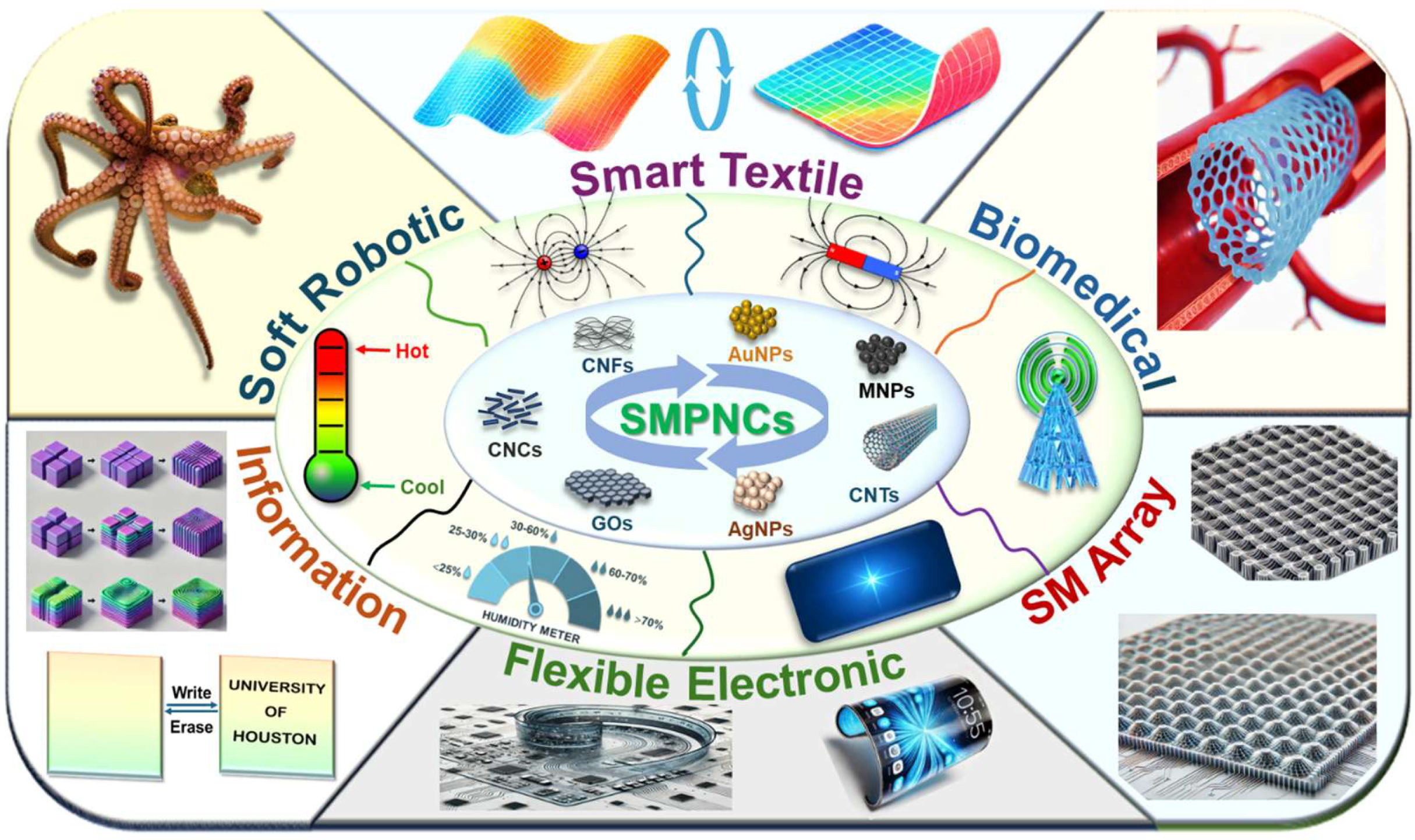


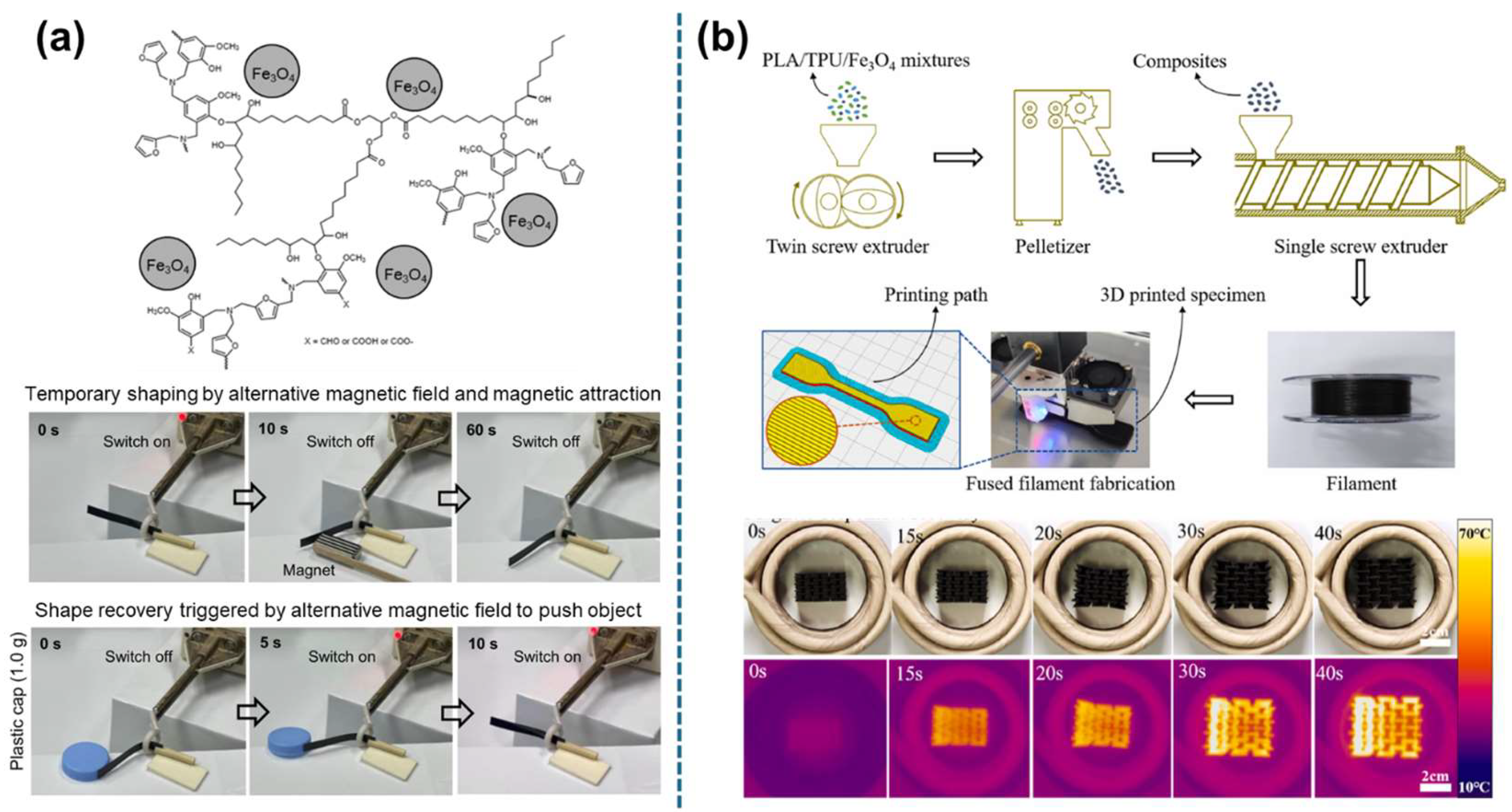
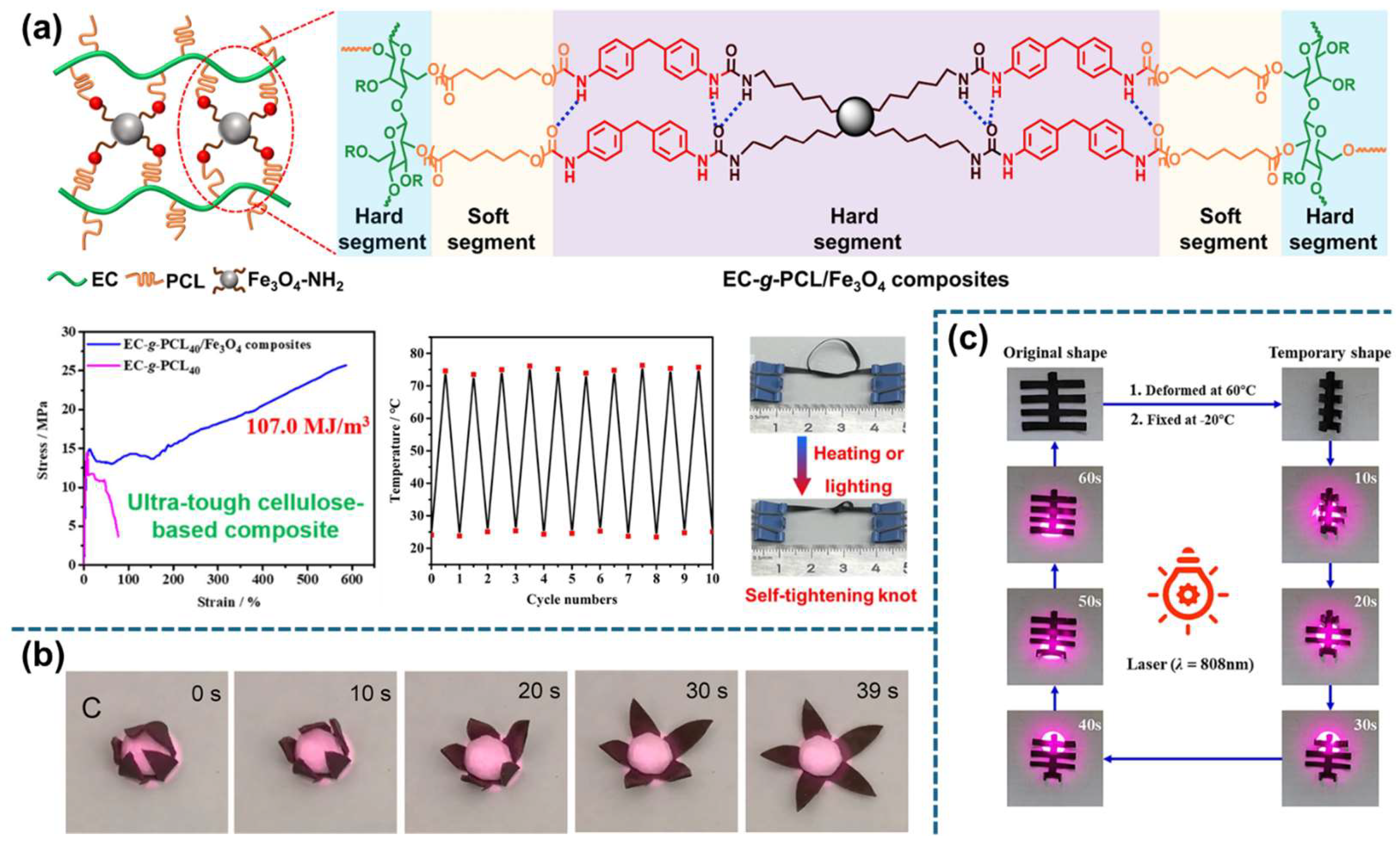

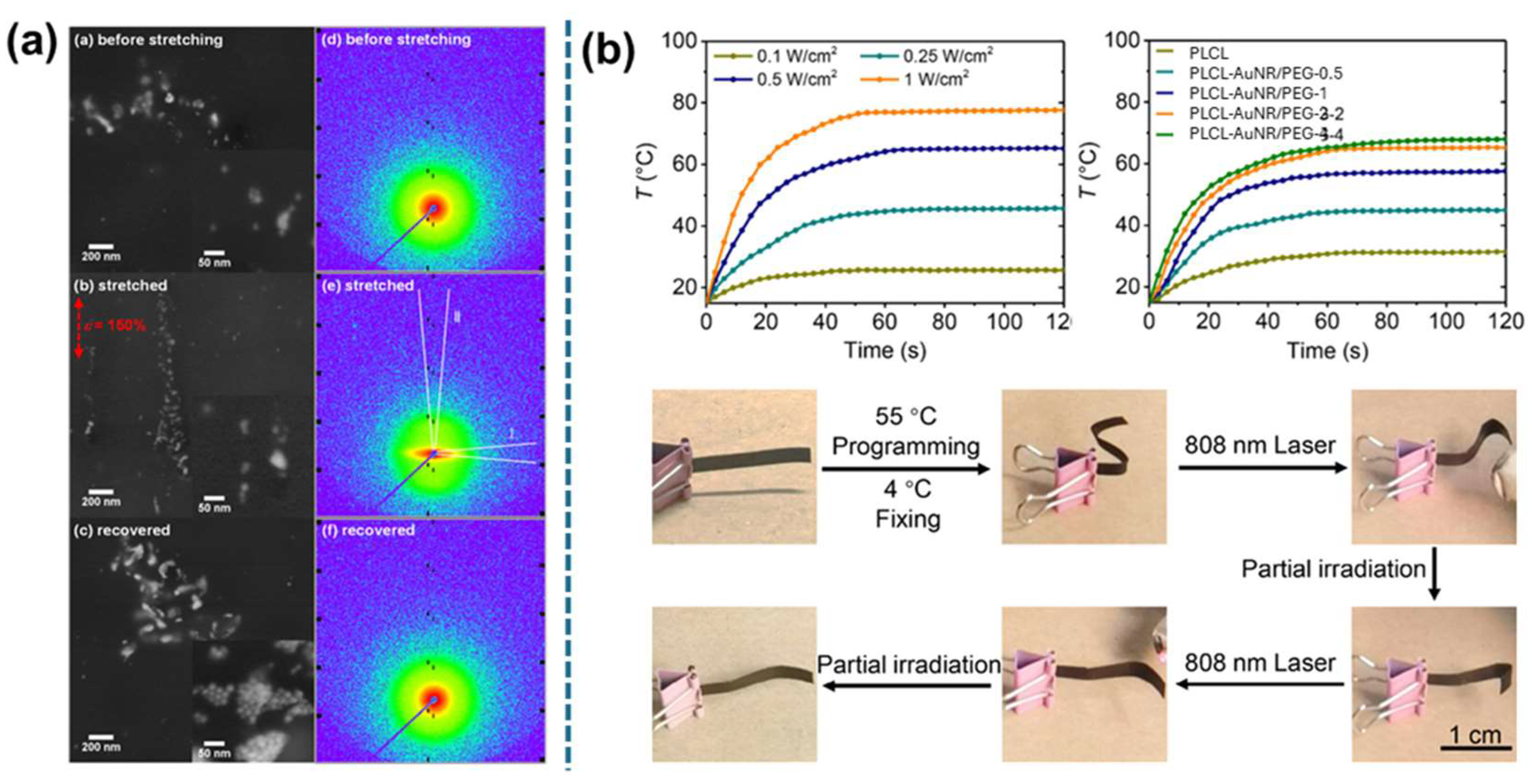
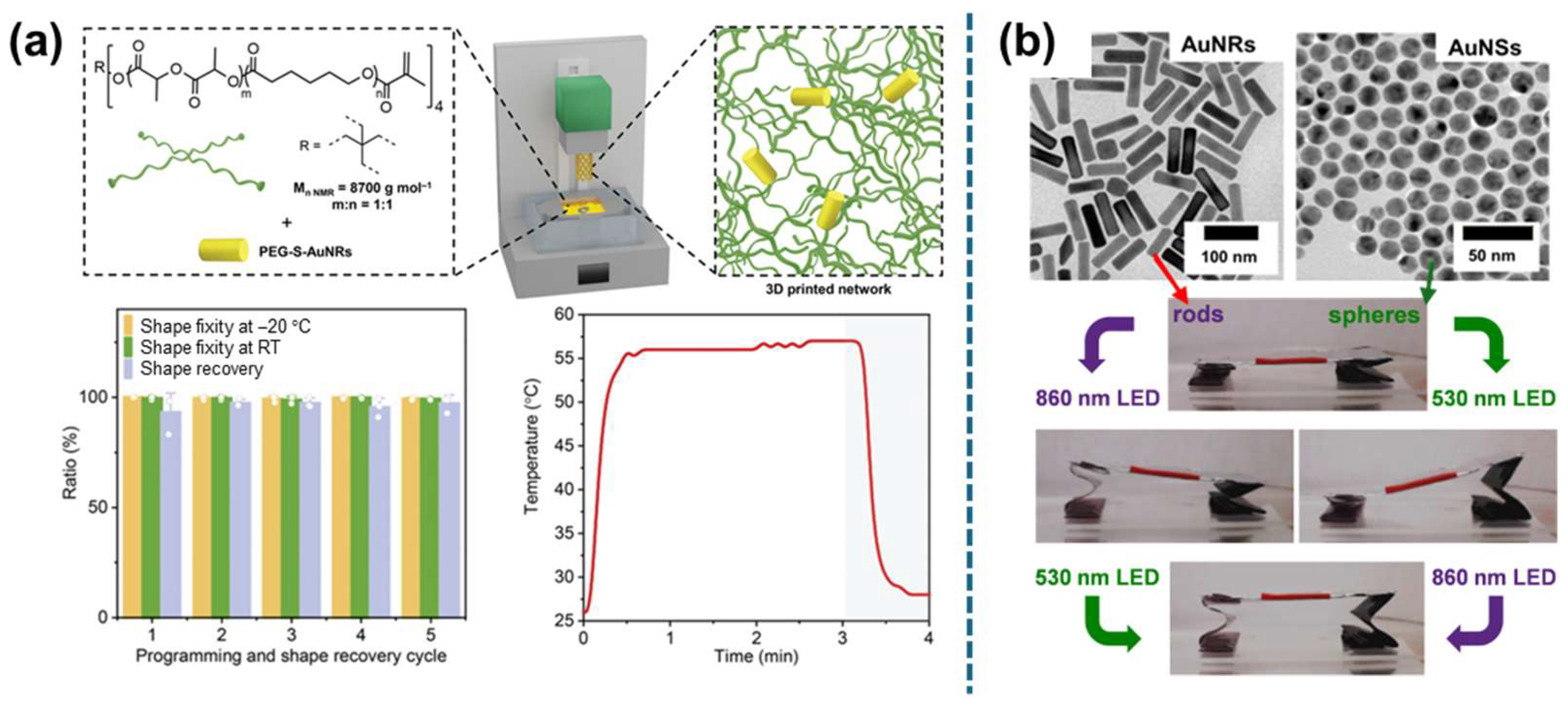
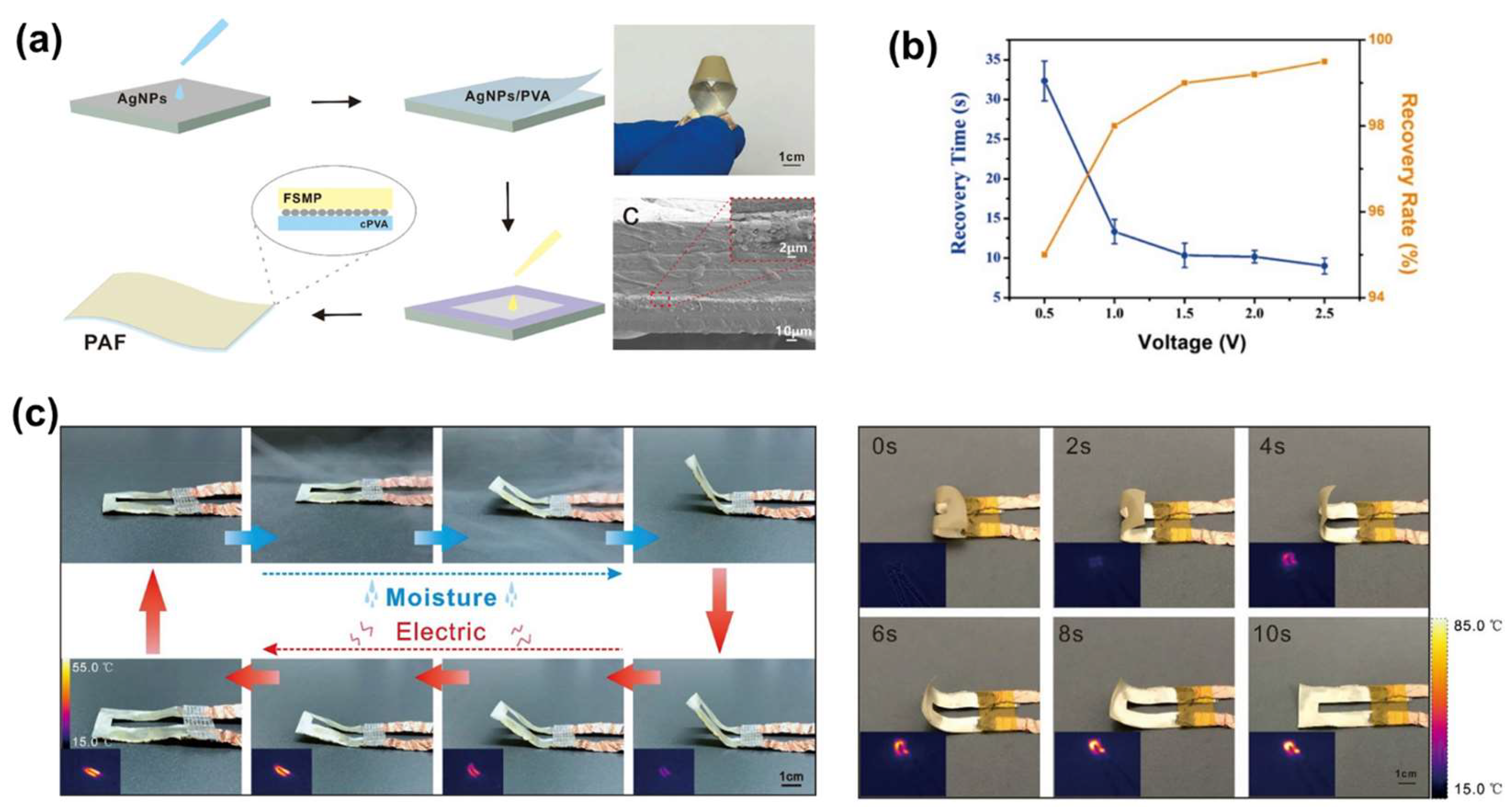



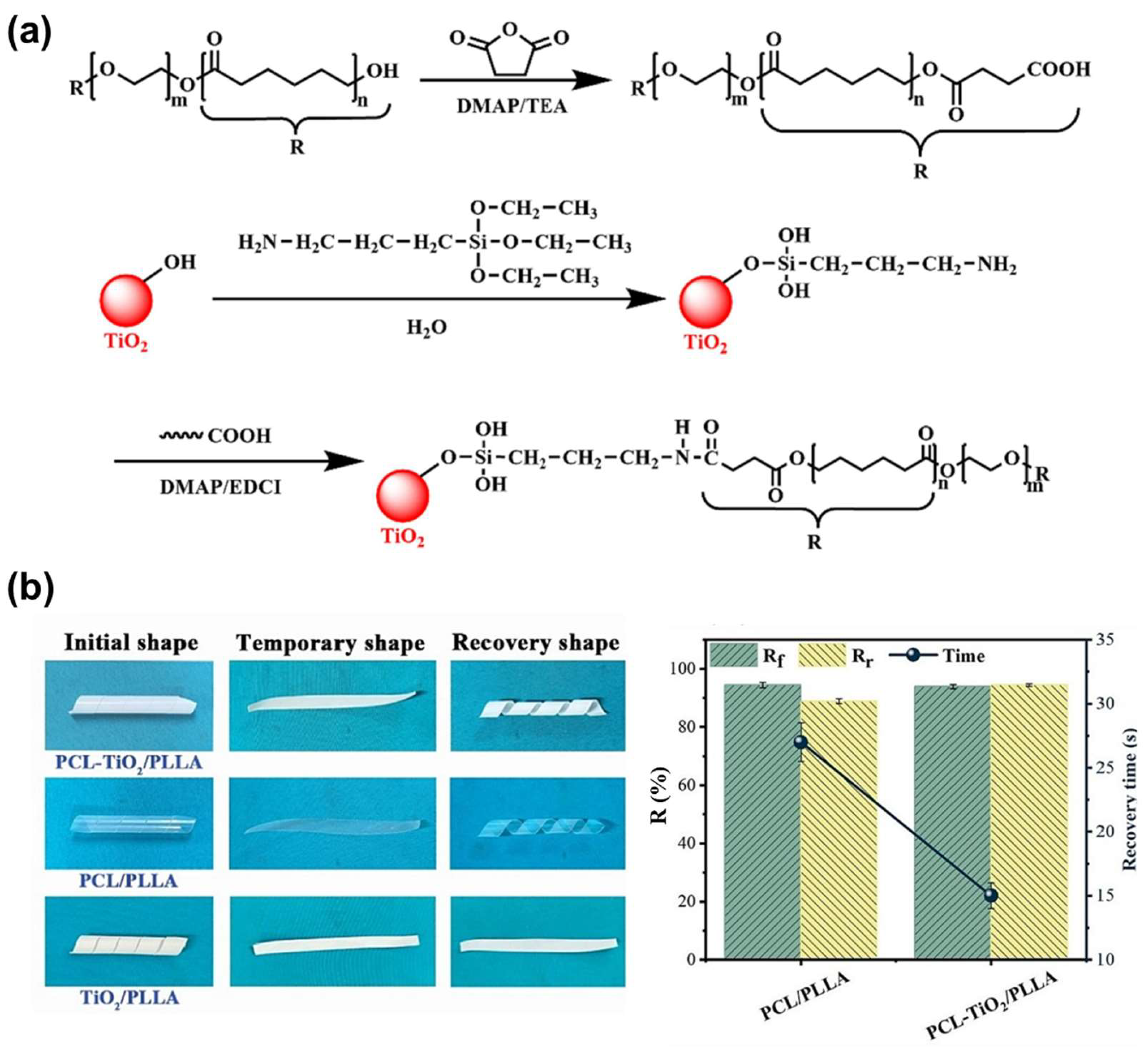




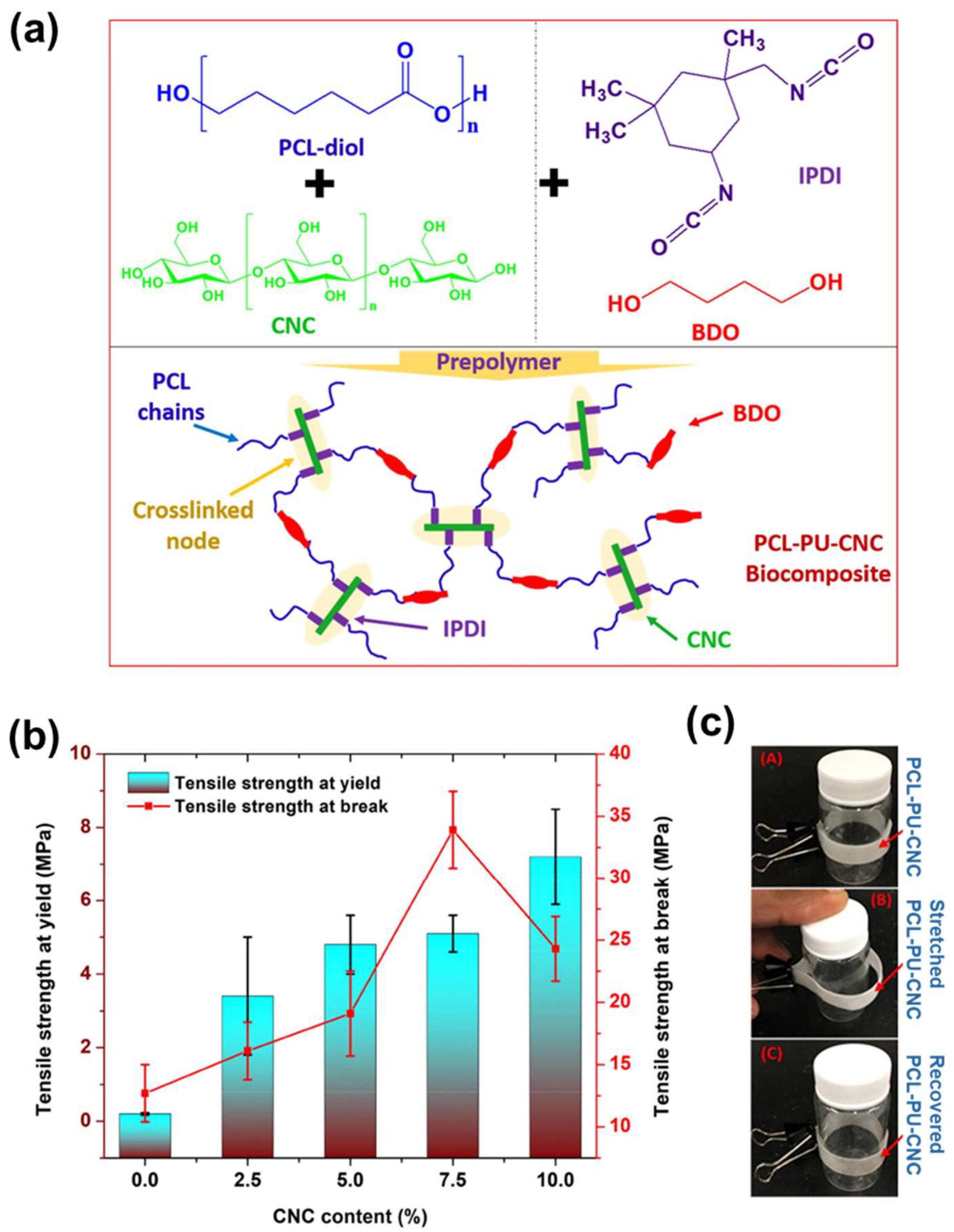


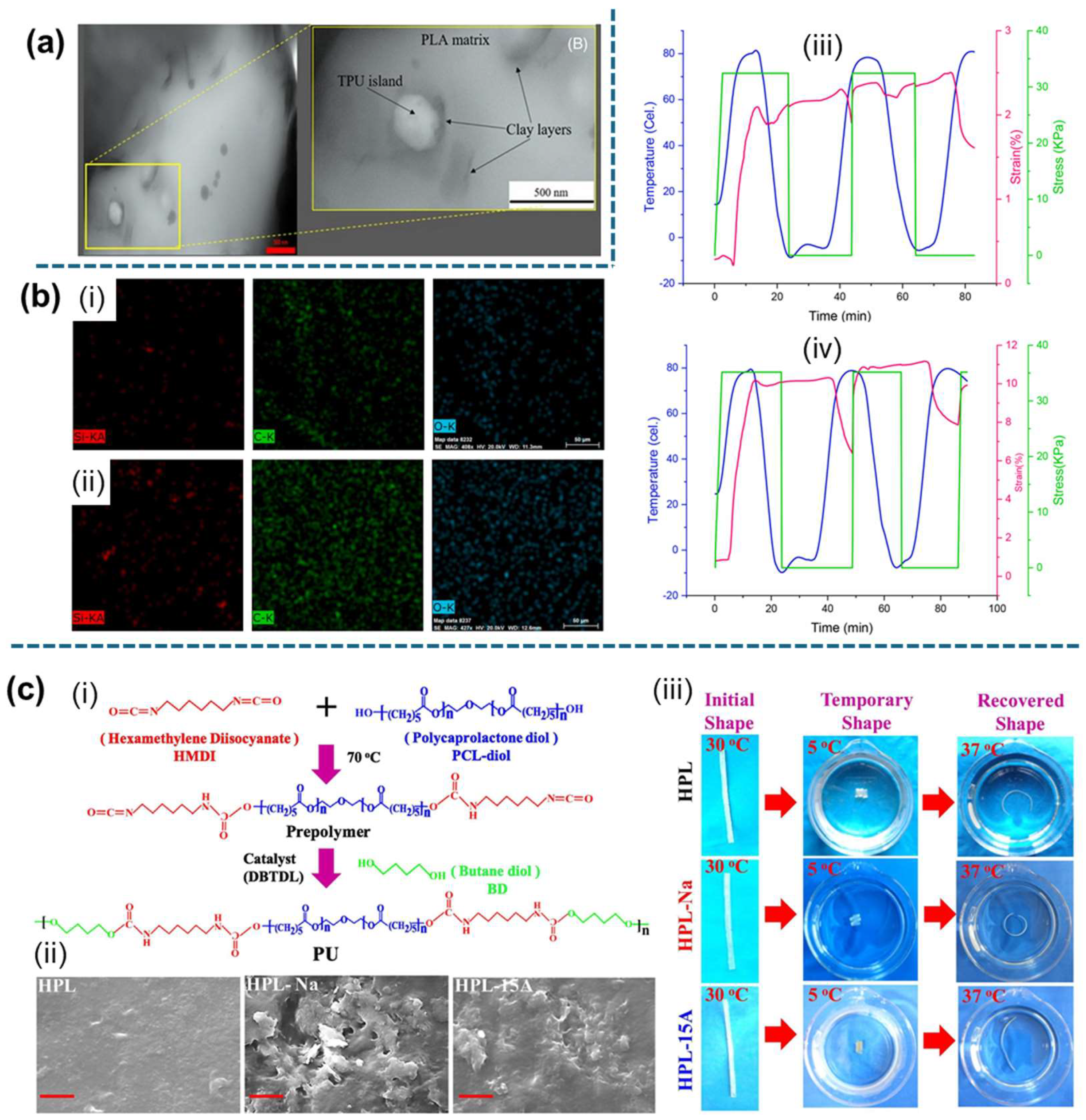
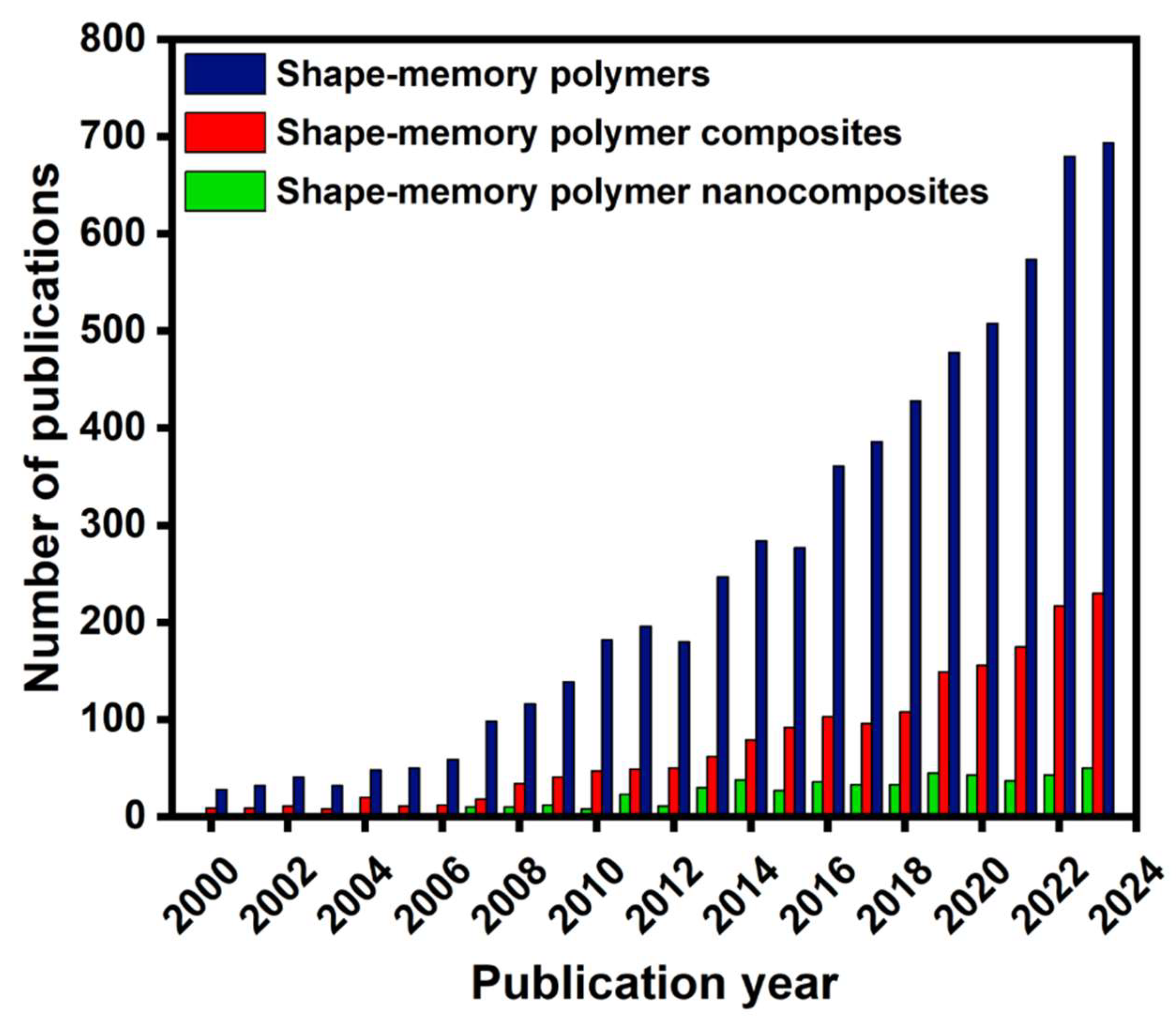
Disclaimer/Publisher’s Note: The statements, opinions and data contained in all publications are solely those of the individual author(s) and contributor(s) and not of MDPI and/or the editor(s). MDPI and/or the editor(s) disclaim responsibility for any injury to people or property resulting from any ideas, methods, instructions or products referred to in the content. |
© 2025 by the authors. Licensee MDPI, Basel, Switzerland. This article is an open access article distributed under the terms and conditions of the Creative Commons Attribution (CC BY) license (https://creativecommons.org/licenses/by/4.0/).
Share and Cite
Islam, R.; Maparathne, S.; Chinwangso, P.; Lee, T.R. Review of Shape-Memory Polymer Nanocomposites and Their Applications. Appl. Sci. 2025, 15, 2419. https://doi.org/10.3390/app15052419
Islam R, Maparathne S, Chinwangso P, Lee TR. Review of Shape-Memory Polymer Nanocomposites and Their Applications. Applied Sciences. 2025; 15(5):2419. https://doi.org/10.3390/app15052419
Chicago/Turabian StyleIslam, Rafiqul, Sugandika Maparathne, Pailinrut Chinwangso, and T. Randall Lee. 2025. "Review of Shape-Memory Polymer Nanocomposites and Their Applications" Applied Sciences 15, no. 5: 2419. https://doi.org/10.3390/app15052419
APA StyleIslam, R., Maparathne, S., Chinwangso, P., & Lee, T. R. (2025). Review of Shape-Memory Polymer Nanocomposites and Their Applications. Applied Sciences, 15(5), 2419. https://doi.org/10.3390/app15052419







